Alumni
The Institute of American Indian Arts (IAIA) has graduated more than 4,000 students, representing more than 90% of the 562 federally-recognized tribes. More than 20% of IAIA alums have earned a graduate degree. Many alums enjoy successful careers in the arts right here in Santa Fe, New Mexico.
Alumni Spotlight
IAIA is the birthplace of leaders in contemporary Indigenous arts and cultures. That statement may sound lofty, but we can back it up. We have a lot to be proud of, but what fills us with awe are our intelligent, creative, and resilient students and alums. Over the past 61 years, many of our students have become contemporary art superstars, critically acclaimed poets and authors, pioneering scholars, civil rights activists, museum professionals, forward-thinking educators, and cultural leaders, shaping future generations.
Read our Alumni Spotlights to learn more about how our alums are carrying connections forward, and check back in the future as we add more profiles of the movers, shakers, and changemakers who have called IAIA their educational home.
If you would like to be considered for a future Alumni Spotlight, contact communications@iaia.edu.
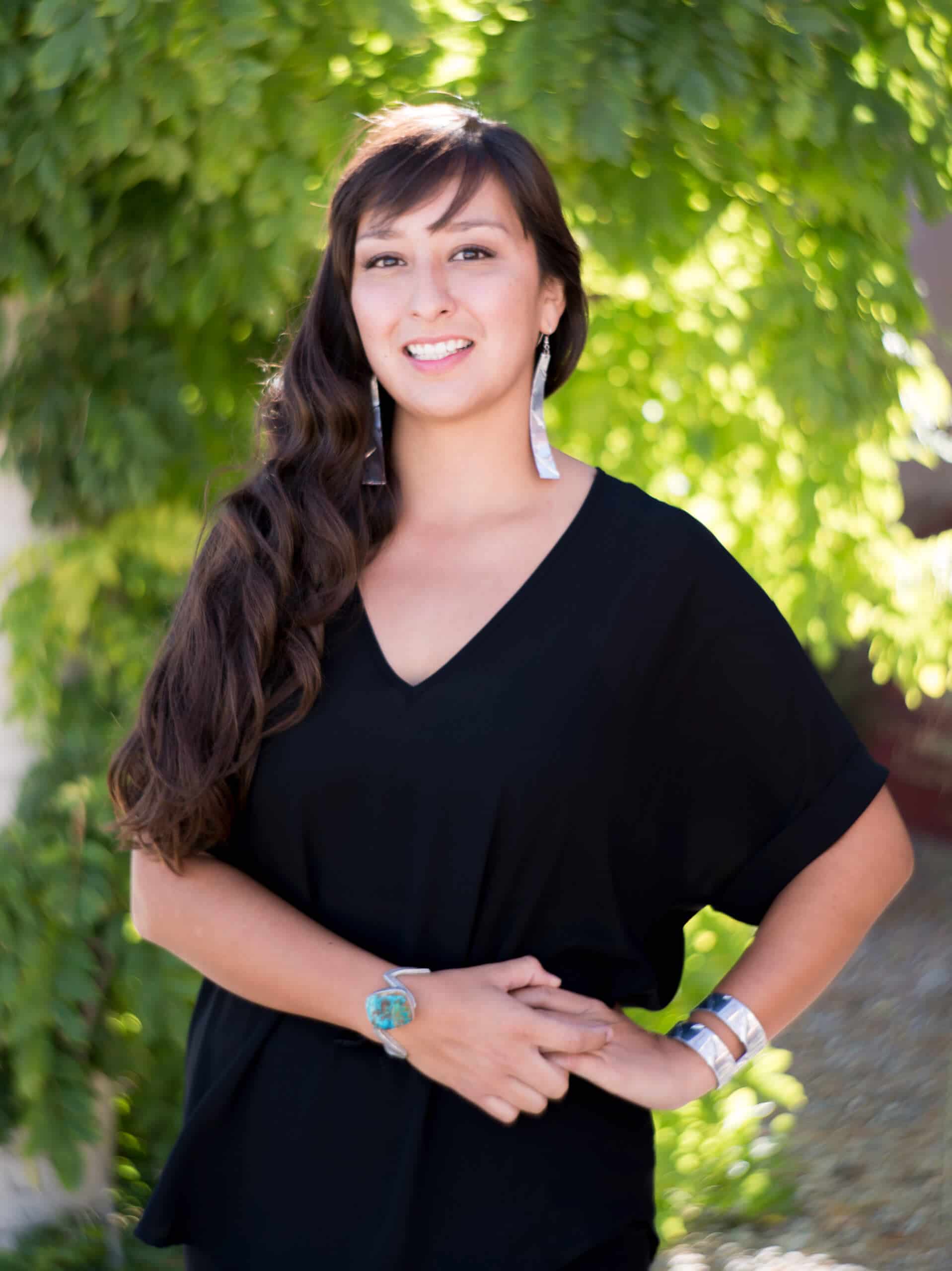
Tazbah Gaussoin ’15
(Picurís Pueblo and Diné)
Profile
Gaussoin grew up with a family in the arts, learning silversmithing from her mother, Connie Tsosie-Gaussoin (Picuris Pueblo and Diné) and brothers Wayne, David, and Jerry; modeling for her family; and being inspired to sew. One of her leather bags was included in We Walk Together in Strength, her family’s group donation for the 2023 IAIA Benefit & Auction.
Gaussoin credits her late father, Jerry Gaussoin Sr., for her decision to pursue Museum Studies at IAIA. “Every time we’d go to an art show with my mom and my brothers, they would be at the booth selling,” she shares. “And if I wasn’t playing underneath the booth table with my Barbies or Madeline doll, then my dad was taking me into the museums and walking me through the exhibits.” After Gaussoin graduated from St. Michael’s High School in Santa Fe, New Mexico, she attended an expansive university. Overwhelmed by some of the comparatively large classes, Gaussoin went to IAIA instead with her family’s encouragement.
After graduating with her BFA, Gaussoin was invited to join a meeting for the School for Advanced Research’s Guidelines for Collaboration for institutions and communities, where staff from the Smithsonian’s National Museum of the American Indian (NMAI) were also present. She connected with former IAIA trustee Dr. Cynthia Chavez Lamar (San Felipe Pueblo, Hopi, Tewa, and Diné), who has since become the director of NMAI, and then-Head of Conservation Marian Kaminintz, and inquired about work opportunities. “…I came out of IAIA just with my eyes wide open, feeling like the possibilities were endless…when I briefly spoke with Cynthia at SAR, she had told me to send her my resume. And I did that week, I believe, and sure enough, I was contacted by her and her team and was brought on to NMAI in a temporary trust position.”
She moved to Washington, DC, with her now-husband Carl Sutter and has been in the region since. After several years, she moved on to a permanent position with the collections and archives departments at NMAI. “That position was really incredible. I was working with both departments to be a liaison between the two and Native communities or researchers that were interested in coming to the CRC—the Cultural Resources Center—to see collections and archives from their communities,” explains Gaussoin. In December 2022, she began working in the NMAI director’s office as an assistant to Chavez Lamar. “It’s been a whirlwind of changes from my previous positions at NMAI—it’s been so incredible to be able to have that privilege of seeing a leadership position firsthand with someone so incredible as Cynthia.”IAIA’s experiential undergrad Museum Studies classes with faculty such as Dr. Jessie Ryker-Crawford (White Earth Anishinaabe), the MFA in Cultural Administration Director, helped prepare Gaussoin for the NMAI workplace. “And I mean, really, when I first started working at NMAI, all of the classes that I had taken at IAIA had helped with jumping into collections work because even though it was with the Community Loans Program, we were still hands-on with.” A class project even came with her: “…we had to make a clamshell box that was made out of coroplast, and then within it, it had all kinds of different archival materials that are used in museum collections,” she explains. “And that was a huge help because I brought it out here and used it occasionally as a reference.”
Adjunct Professor and IAIA Archivist Ryan Flahive’s oral history class proved to be particularly pivotal to Gaussoin’s work. Since her senior project focused on Picuris Pueblo and an excavation there in the 1960s, she interviewed two Picuris Pueblo elders. During her interview with the late former Governor Joe Quanchello, some sensitive information arose. She discussed the situation with Flahive. He advised her to talk to the elder about it, and she ultimately decided not to use it in her project. “…I loved that about IAIA and having that understanding of sensitivities and such,” she notes. Gaussoin also interviewed Picuris Pueblo elder, tribal historian, and former Governor Richard Mermejo. “And I think most elders saw me as, like, ‘Oh, that’s Connie’s daughter,’ and so when I went and asked him about the interview, it started that relationship, and I still am able to continue that relationship with him, and it’s evolved from there.” During the pandemic, Gaussoin attended a Tiwa language class via Zoom taught by Jordan Fragua and Picuris elders, including Mermejo.
At NMAI, Gaussoin searched for Picuris Pueblo items in NMAI’s collections and archives and found photos of Picuris Pueblo from the early 1900s. In February 2020, Gaussoin brought NMAI archivists to Picuris Pueblo for a photo documentation project. “It was so cold the day we went. There was this huge snowstorm.” However, they were warmly welcomed by her family and other Picuris Pueblo members with a potluck. Community members, including elders such as Gaussoin’s late maternal grandmother Lydia Duran and Mermejo, shared information to accompany the Picuris photos. The participants chimed in with each other and built upon the stories shared. “…and it was so cool to be able to hear different perspectives from different families,” she says.
“And it was not just NMAI gathering that information to be able to put it back into the archives for further documentation and how Picuris people want it, but also, NMAI provided the high-resolution images to Picuris for their future use,” she emphasizes. Gaussoin credits IAIA with giving her the “courage” and “support to be able to reach out to community members from your community to be able to do these projects.”
Gaussoin set aside grad school when she began working at NMAI, but a new possibility arose during the annual Heard Museum Guild Indian Fair and Market. “My brother Wayne and I were sharing a booth, and IAIA had a couple of folks walking around with the big news of the MFA program for Cultural Administration. I was like, ‘Wait, what?!’ I was freaking out because I had been in search of a master’s program that I was truly interested in for what felt like so long,” she says. The application deadline was quickly approaching. “And so, David and I were talking, and we’re like, ‘Well, I’ll do it if you do it.’” She and David became part of the inaugural summer 2022 cohort. The low-residency format allows her to study while working and prioritizing family, and she values the administrative point of view from Native perspectives. “… having that knowledge to be able to use that in my work today is so important,” she asserts.
Visit www.najaclub.com to see works by Tazbah Gaussoin and family.

Russell Frye ’15
(Pueblo of Tesuque)
Profile
This year, Frye won a first-place blue ribbon at SWAIA Santa Fe Indian Market for a glass sculpture. The annual IAIA Student and Recent Graduate Art Market allowed him to get his “foot in the door of what it was like to be at Indian Market” and gave him “more experience doing markets.” He has also shown at the Poeh Cultural Center’s Pathways Indigenous Arts Festival, and he is represented by Gallery Hozho at Hotel Chaco. Frye was previously represented by the former Shidoni Gallery and Sculpture Garden and has displayed work with the New Mexico Glass Alliance at the Albuquerque Sunport.
At IAIA’s annual Benefit & Auction this year, he was a guest at the table of renowned glass artist Dale Chihuly, who is notable for helming a glass program in the early days of IAIA. However, when Frye was a young student at IAIA, “there was nothing” offered for glass, but now, IAIA has a “full-blown glass studio.” Recognizing Chihuly’s connection, he shares, “So, it’s kind of cool to see it, you know, come full circle now, where we have a new glass program emerging at the new campus.”
After graduating in 2015, Frye took a break from glass. “It’s been about a year and a half now since I’ve been making art again,” he mentions. In the time between, he pursued another creative pursuit. “I was cooking before. And I loved the restaurant biz. Like there was a restaurant in my hometown that was owned by this family that were good friends of ours, that my dad would go fishing with, and they had kids. So, we all grew up together,” he shares. “But yeah, I think like, just like, I love that family vibe of a restaurant and feeding people. I love that, and food in of itself is a form of art, you know, totally.” The Museum of Indian Arts and Culture exhibition Clearly Indigenous: Native Visions Reimagined in Glass prompted him to return to glass. “And I was just like, ‘Okay. I gotta get busy,’ with like a lot of signs happening telling me to get back to work again.”
He views the process of glassblowing as similar to the cooking experience—both are challenging sensory experiences. “And in the same way, it kind of reminds me to cooking—being in a kitchen where there’s just all this commotion, especially during a rush. Of like—you’re just having to get into this flow state, I guess. And so, I think there’s something about that—that I am able to get into this flow state. And for me, that’s how I’m able to create, and it’s also good for just my emotional well-being, honestly, like I’m able to process a lot of stuff that I’m thinking about in that state of mind.” The satisfaction of seeing progress is “really rewarding,” as is the response of others. “And even seeing people’s eyes, you know, and whether you make them a great dish, something really good to eat, like they know that it was made with love—or an incredible piece of art.”
Frye first learned to work with glass during a group IAIA internship with fellow students Crystal Worl, Monica Gutierrez, Cameron Tafoya, and Daniel Gringnon. “I first started painting, and then I got into printmaking. And I was really—I—if I didn’t find glass, I probably would have settled for printmaking, which I still want to get back into.” Frye credits a lunchtime conversation with Worl for the internship experience. “The story is that IA didn’t offer glass at the school. So, Crystal wanted to do glass for her project. So, she took it upon herself to bridge this partnership with a glass studio in town and IAIA. So, I was part of that original group of kids that got to go for one of their classes off campus.” The group attended the New Mexico Experimental Glass Workshop, directed by Stacey Neff and Patrick Morrissey. “And I was kind of hesitant about taking it. I was like, ‘Oh, I don’t know. I’m scared,’ but it was really the best thing that I—one of the best choices I’d ever made.”
While Frye grew up making art and drawing in high school, he didn’t plan on being a professional artist. He previously attended Fort Lewis College, where several family members went. “I don’t think I was honestly ready because I was going from the Ramah-Navajo rez straight up to, like, you know, white, privileged Colorado—it’s culture shock, immensely. And so, I didn’t last there. I did one year, and I came back down to Santa Fe, and I was with my family.” His grandmother suggested he go to IAIA. “And I was like, ‘You know what, Grandma, you’re right,’ and I applied, and I was like, you know, a little hesitant, but it was honestly the best thing for me because I was able to mature at IA.” IAIA provided him structure, independence, and “a very safe space” to grow. “And I was like, ‘You know what? I want to be an artist.’ Something, it clicked. And being around other people and seeing all the amazing artists that were coming out of IA, I was just like—and my family and the connection—I was just like, I felt like I’d found my home.”
As children, Frye and his siblings were provided with a variety of art supplies by their father, who was an art teacher. His parents were also both ceramists. Frye and his siblings would make pinch pots with the clay. “I think I was never satisfied with my pinch pots, though, and my brothers and sisters were always so much better at their pinch pots—frustrated about this,” he emphasizes. His brother Jacob Frye has since become a potter. “I still wanted to create pottery, though, and I was fascinated. I think it was seeing, yeah, Tony’s work—Tony Jojola—how he was able to do these pottery shapes in glass. And I don’t know—I think that’s when something clicked, and I wanted to be a glass artist because I knew I could still stay true to my family, and, you know, working with these forms, but in a different way.” Recently, Russell Frye showed vessels and plates made of glass and bronze in Gallery Hozho’s sales show, The Fryes and Friends. “I did some pieces recently in bronze that were kind of taken from that traditional Pueblo form, but done in bronze, and it was kinda cool how I did it, too, because I was coiling the wax—you know, very small little coils, which is very similar, you know, to how they did it in the early days—just very small little coils of clay.”
Frye’s ongoing education in glass has included working with notable Indigenous glass artists. Frye first met the late Tony Jojola (Isleta Pueblo) ’76 during his IAIA internship. “And then it was last year that I got to actually work on one of his pieces, which was amazing.” Frye sandblasted a design for Jojola shortly before he passed. “I was really sad, you know. So, it kind of broke my heart that we lost him so early.” Jojola “was a big mentor” to glass artist Ira Lujan (Taos and Ohkay Owingeh), who also trained out of Prairie Dog Glass. Lujan and Frye recently conducted a “Hot Stuff Glass Demo Day” together for Gallery Hozho. “I thought they were gonna put us on the parking lot or on the sidewalk, but we were actually on the street. So, our bench, when we’re making the glass, we had cars just driving right next to us. Very different than in the studio; it is more a street performance than anything, which I can’t wait to do it again.” Frye has also learned from Robert “Spooner” Marcus (Ohkay Owingeh) A-i-R ’18, another notable glass artist. “To have these people, you know, and to be able to work with them is, yeah, it’s kind of a—I don’t want to be cliché, but it is a dream come true,” says Frye.
More experimentation is in the works for Frye. “Yeah, I think that you’ll probably see more of my glass being incorporated with metalwork,” he says. The collaborative context at IAIA fosters the exploration of new techniques. Studio Arts Faculty Craig Tompkins worked with Frye to create a 3D print. “And I haven’t shown it to the world yet.” He plans to use the 3D print as a mold to cast work. “And then even Jasmine Novak—she’s taking the glass class this semester,” he shares. “And she, bless her heart, has been hard at work, and she’s actually creating some really remarkable stuff over there. She’s getting it ready so that we can do glass castings now. So, I might take this piece—instead of casting in metal, I’ll be able to cast it in glass now because of what Jasmine’s been able to do over there.” Novak is working on a fox and rabbit. “And then I have this cow that I want to do. So, I think you’re gonna see a lot of little glass animals coming,” he chuckles.
Keep up with Russell Frye’s next moves through www.russellfryebread.com, Gallery Hozho, and his Instagram account @russell_fryebread.
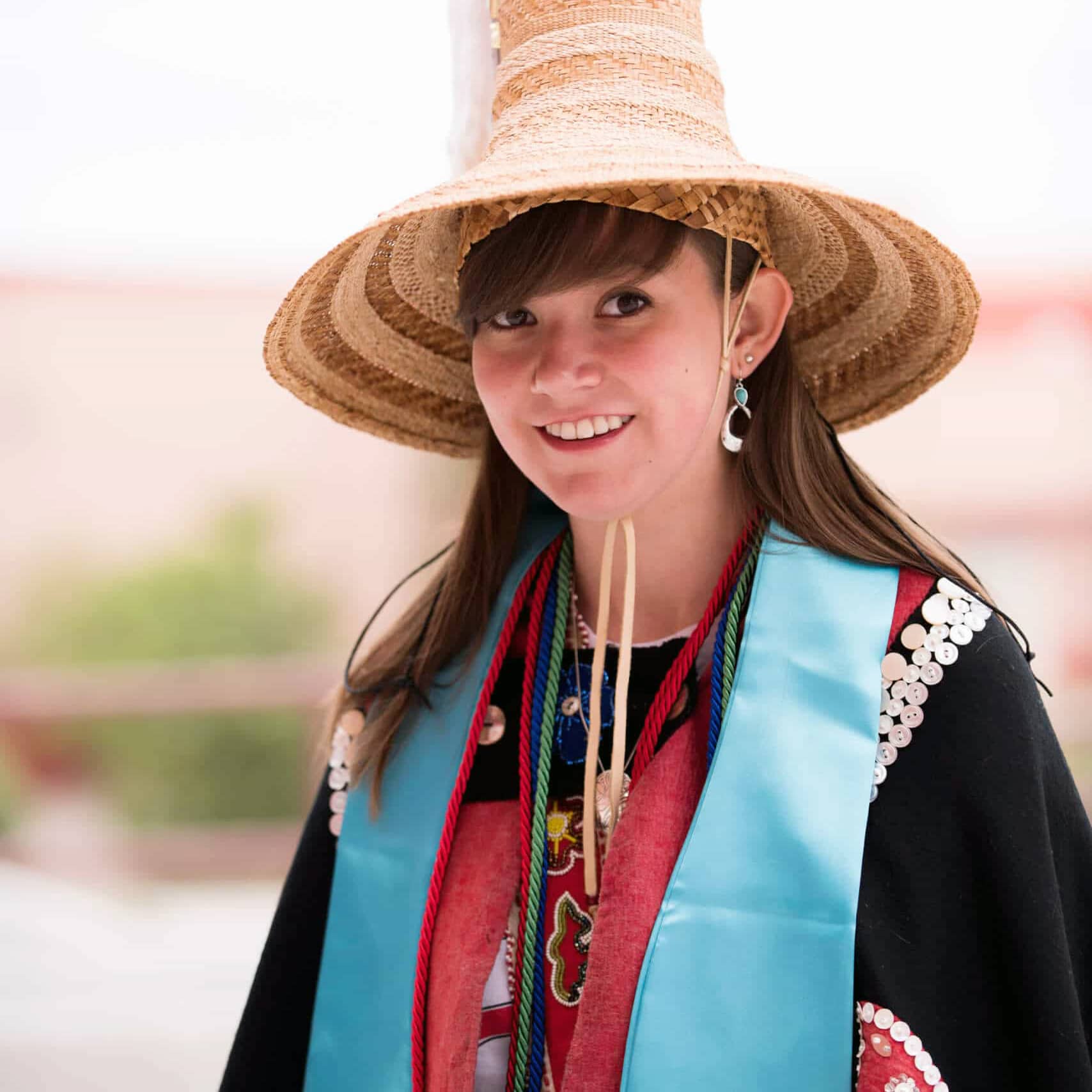
Sydney Isaacs ’16
(Tlingit)
Profile
When Isaacs was a student, IAIA’s Cinematic Arts and Technology degree didn’t exist as it does today. However, she saw the potential of the cinematography program to connect to her interest in animation. “I already knew I wanted to animate, but I understand the same principles can apply, like camera angle—studying story, script writing—there’s a lot there that could be used. And so, I would try to find ways to make all of my assignments include animation of some sort. I had to teach myself a little bit of animation through YouTube. But then, thankfully, near the end of my time, more animation courses became available with instructor Craig Tompkins there, and he was the one that taught us the fundamentals of animation, and I think the animation program has been growing ever since.”
IAIA Board Member Princess Daazhraii Johnson (Neets’aii Gwich’in) was then working as the creative producer of Molly of Denali, which was released in 2019. “And so, when it was first kicking off, the goal—and it still is the goal—was for this show to take on Indigenous people, preferably Alaska Native people and other underrepresented voices to give us a seat in the room, behind-the-scenes, in all areas of the show’s production to make sure we are being represented appropriately and authentically,” Isaacs emphasizes. IAIA and GBH had partnered together to create a fellowship to advance this goal.
After graduating from IAIA, Isaacs was contacted by IAIA President Dr. Robert Martin (Cherokee Nation), who remembered her student work. “It was such a surprising conversion because he called me and said, ‘If I remember you correctly, you’re Alaska Native and are passionate about animating cartoons. There is this incredible opportunity that I think you should apply for.’ And he told me about this Alaska Native cartoon show that was being created by GBH Kids. I was shocked because Dr. Martin, who is probably very busy, remembered who I was and made time to contact me. That was amazing. And to think there was an actual animated cartoon show about Alaska Native culture being created with a spot open for someone to join was mind-blowing for me. That’s literally everything I’ve ever wanted to do and couldn’t dream of a better, perfect path. And so, I waited, and IAIA kept me updated with the application status.” When the application went live, Isaacs applied, interviewed, and was selected as the 2018 IAIA Molly of Denali Fellow, working with GBH in Boston, Massachusetts.
The experience was, as Isaacs explains, “being a fly on the wall and observing how things would work.” She shadowed a production assistant on the show “because that’s essentially what I would be doing should I be hired anywhere else.” The paid fellowship time covered 10 weeks for about four days a week for three hours a day. After considering how she might get more out of the experience, Isaacs approached her managers to ask if she could volunteer additional time to match the hours of the regular staff “just to see how it all functioned” and get a more accurate picture of the work ahead of her. The managers agreed to let her donate her time. “I think that’s probably what led to them hiring me on,” she notes.
She became a production assistant and was subsequently promoted to production coordinator in 2021. However, her ambition didn’t stop there. “I’ve always wanted to write too. With IAIA just being a smaller school, we typically got to do everything. We were the editor. We were the story writer, the creative everything—storyboards, all of it,” she shares. She considered leaving her position to pursue writing fellowships but came up with another approach to write. “I pitched another idea to them, basically, where I asked my executive, ‘Hey, what would you think about me practicing writing, as in I’ll take the backseat. You don’t have to note on anything. But could I pretend to write a story and match another writer’s deadlines just to see if I could do it? So, when they write a premise, I will write a premise, and then, when it’s time to make a scene-by-scene, to get to that date, I will do that all the way through until the final draft. Do you think I could do that?’” Isaacs explains. The executive agreed, with the understanding that her primary job duties came first, and told her to not expect to receive notes.
Isaacs went through the process. “My executive producer pulled me into her office, and she was like, ‘So, I love your story, and so does everyone else that has read it. And we were wondering, would you be okay if we put it into the pipeline and actually made it, animated it, the whole shebang?’ And I was like ‘What! Oh my gosh—yes!’” Her first Molly of Denali story, “Art from the Heart” was released on MLK Day this year, and she is currently working on another story for the series, with more ahead.
In January 2023, Isaacs advanced to her current position of associate producer. She works closely with current creative producer Yatibaey Evans (Ahtna Athabascan) and coordinates with the Vancouver-based Atomic Cartoons, GBH’s partners on Molly of Denali. “Atomic Cartoons covers Molly of Denali’s overarching design, characters, design backgrounds, animation. In season one, I believe Atomic had no Indigenous people working on the show,” Isaacs explains. “And now we have at least 10, which is a huge deal.”
Issacs’s work as an associate producer is expansive. “You have your hand in just about everything,” she notes. “It’s reviewing all designs. It’s reviewing all animatics. It’s reviewing all stories. As soon as the idea comes, to seeing it completed and created throughout the whole animation process. It gets as detailed as creating the theme song for Molly before Molly had one. Naming characters.… It’s a lot of collaboration and bridge connecting with different departments, to make sure everything that’s related to the show is authentic and honest. And I get to have a voice and hand in creating all these things that are released for Molly.”
Isaacs has been able to apply her own knowledge of Northwest Coast and Tlingit art to the show. “There are a couple of stories that involve the Tlingit culture and art, like totem poles. And since I grew up learning my traditional and cultural arts from my Master Carver, even becoming a totem pole carving apprentice, I would casually slide that fact into conversation so my executives and other colleagues would know I had expertise in that area—that they should really consider what I have to say. And my executive producers, they were a little hesitant at first, but when I was able to explain more, take time, and let them know what was going on or how certain things should be crafted, it became very apparent that they trusted me and asked if I’d be able to help our artists with creating Northwest Coast Art. And I said, ‘I could definitely try.’ And from there, just about anything that relates to Northwest Coast art is coming from me.” Her drawings are “Molly-fied” by Atomic Cartoons, which avoids inappropriate copying of Northwest Coast artists and inaccurate portrayals of Northwest Coast cultures.
Molly of Denali has grown to include many Indigenous people. “Outside of GBH’s Production team, there are Indigenous people working in a lot of different seats—it’s so cool. Our voice actors who portray Indigenous people are actually Indigenous themselves,” Isaacs reveals. “Even our writers—a good chunk of them are Indigenous. I’m trying to think of how many Indigenous people we have working on the show. We’ve been growing since season one. I think, to date right now, we’re at 111 unique Indigenous contributors. When we first started, there was maybe 60 or so. We’ve been slowly growing our capacity. Our growth goes into everything you could think of—designers, artists, animators, voice talent, directors.”
Molly of Denali’s Alaska Native cultural and language advisors are essential. “And so, we partner with and work with elders and other folks who are actually fluent, or darn near fluent, in the languages we’re using, and they will help us identify what words [to use], how to pronounce these words for voice actors to learn because they themselves aren’t as familiar sometimes with the different languages and dialects. And then also, at every stage of production, we have an Alaska Native advisor paired to the story. So, no matter what, an Alaska Native advisor will be there just to make sure we’re as authentic as we can be. There’s always somebody of Indigenous relations that will oversee any story being made, from scripting even into designs and animation.
For example, when IAIA Alum and illustrator Chad L. Yellowjohn (Shoshone-Bannock and Spokane) ’19, worked as a fellow on the show and designed characters for “Homemade Heroes,” the first episode of season three, the process was collaborative. “All those comic book heroes, the way that Molly and her friends look, that’s Chad’s design. He created it. He worked with our advisors—our cultural advisors—took their advice and what it should look like to be an Indigenous superhero, and his designs just blew us out of the water, honestly.”
Molly of Denali has impacted how other shows are being created inside and outside of GBH. “And then also on top of that, it is like the shows that we’re making within GBH, they’re looking—a lot of people are looking at the ‘Molly Model.’ Everyone keeps doing it, the ‘Molly Model.’ And they look at that inclusion, that type of drawing people in, and they let new and unheard voices come in, pitch their ideas, because that’s where freshness, where pure, great content comes from. And it’s been going really well, honestly, for these other shows, too. We’ve seen a lot of change in how we’re onboarding, how we talk to people, how our internal meetings go. Inclusivity, transparency.”
Working on Molly of Denali fulfills Isaacs’ major creative and cultural wishes. “It’s done a lot for me, because if I’m being very honest, I never thought that I’d be working for GBH, or someone affiliated with PBS and educational material. But, when I really think about it, which I’ve been doing quite often lately, that’s essentially what I’ve always wanted to do and where I’ve wanted to work without me realizing it. And I’m going to keep teaching about Alaska Native culture, Indigenous people, our values, our oral history and stories—ideally through cartoons and animation.”
There’s more ahead for Molly of Denali. “There’s an epic finale in this season, essentially. We’re going to places we haven’t been before,” Isaacs emphasizes, noting that the show focuses on Alaska and some First Nations peoples in Canada. “It’s exciting to see how much progress we’ve made on Molly, the challenges we’ve overcome so far—it’s all really good! And I hope it leads to more open doors and opportunities for Indigenous people to tell their stories.”
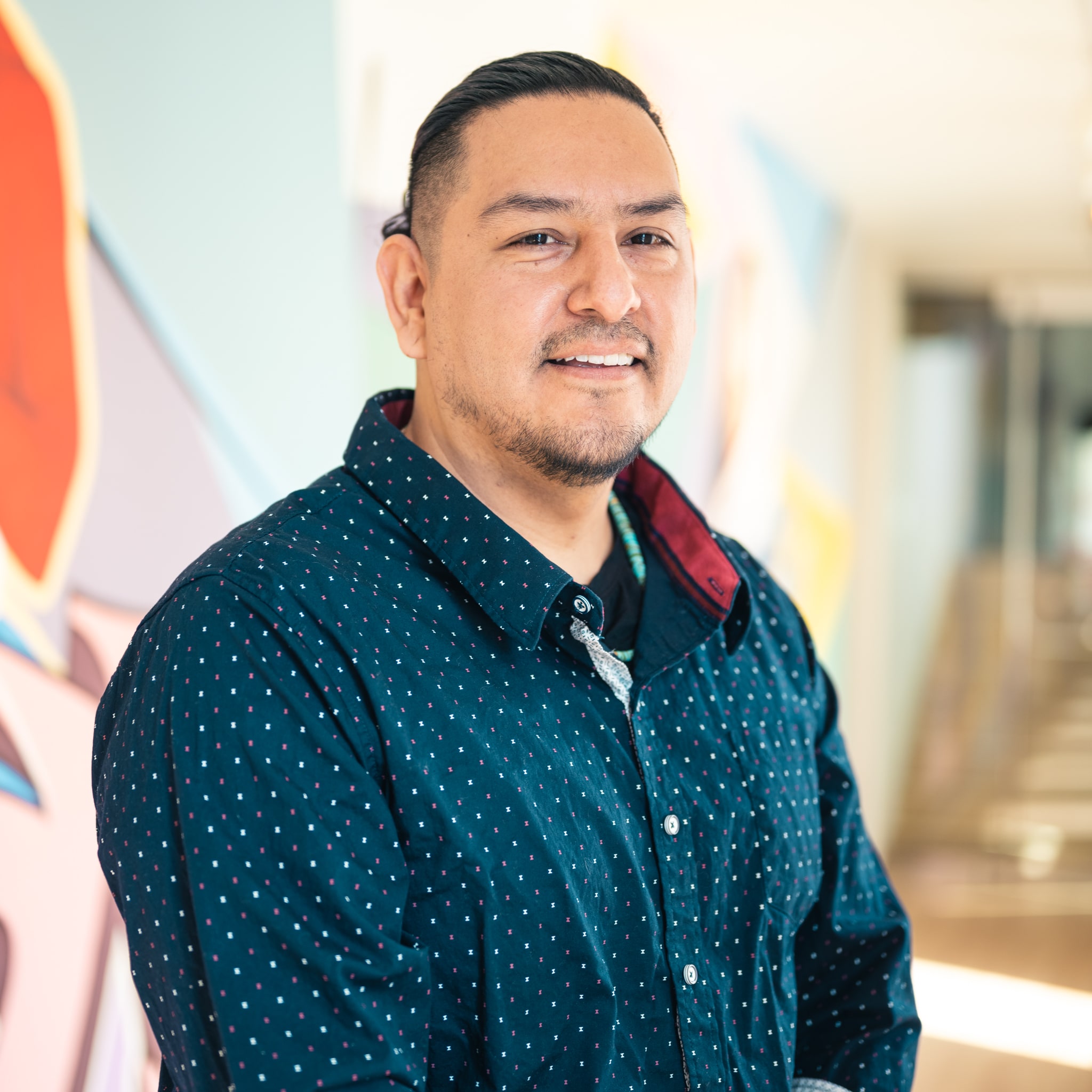
Wayne Nez Gaussoin ‘09
(Diné, Picuris Pueblo, and French Descent)
Profile
Other family have been involved with IAIA. His uncle Robert Dale Tsosie (Picuris Pueblo and Navajo) ’91, has a sculpture on the IAIA campus. His brother David Gaussoin (Diné, Picuris Pueblo, and French Descent) taught classes about the business of art at IAIA and showed work at the IAIA Museum of Contemporary Native Arts (MoCNA). His younger sister Tazbah Gaussoin (Diné, Picuris Pueblo, and French Descent) ’15 was in the IAIA Museum Studies program and is now working at as a museum specialist at the Smithsonian’s National Museum of the American Indian.
Wayne grew up learning to make jewelry from his mother Connie Tsosie-Guassoin (Diné and Picuris Pueblo) and his brother David—he has been working with them for over 20 years. The family, also including Wayne’s brother Jerry Gaussoin Jr., is well-known for their bold, experimental jewelry and their impact on the Native fashion scene. Wayne Guassoin’s work is in the collections of the Peabody Essex Museum (PEM), the Wheelwright Museum of the American Indian, the Museum of Indian Arts and Culture (MIAC), the Museum of Man, the Red Cloud Museum, the Heard Museum, and the Institute of American Indian Arts. His work appeared in PEM’s traveling exhibition Native Fashion Now. He currently has a cuff made from a license plate on display at MoCNA’s The Stories We Carry. Many years ago, Guassoin participated in an August fashion fundraiser for IAIA, which grew out of local nightclub shows with his brother David and the likes of Virgil Ortiz (Cochiti Pueblo), Pilar Agoyo (Ohkay Owingeh, Cochiti Pueblo, and Kewa Pueblo) ‘89, and Patricia Michaels (Taos Pueblo) ‘89, originally for the benefit of the Santa Fe Opera’s Pueblo Opera Program. “And they [IAIA] told us the time that that was the most money they ever made for a fundraiser event,” he reveals.
In 2009, Guassoin graduated from IAIA with a BFA in Studio Arts. Taking jewelry classes at IAIA prompted him to experiment and push “the boundaries of just using other non-precious materials.” These experiences also spoke to his creativity in dealing with financial challenges. “So I would go to the restore, or thrift store, whatever, and get materials and play with those,” he explains. One notable student project was an inlay-style bracelet à la Loloma, made from a sink part and 99-cent bag of sponges. For his senior project, he held a collaborative “interactive sculpture slash performance” at MoCNA. “I brought in all these different artists to interact with the piece—these musicians and performance artists,” he says.
After IAIA, Guassoin continued to pursue his jewelry practice and participate in juried art markets, and he exhibited his work nationally and internationally at galleries and museums. He also began working for a sculptor. “I was learning a lot about working in waxes and creating molds and things like that, and that really piqued my interest and wanting to learn more about sculpture.” Following this interest, he went back to school and graduated in 2016 with an MFA in Art Studio at the University of New Mexico (UNM), with a minor in Museum Studies. “As an artist working with museums, I wanted to work from the inside-out—working in museums, working with artists.” While at UNM, he was accepted into the Lands Arts of the American West program. “And so, I started working with earth and looking at sculpture and more of a temporary aspect as opposed to permanent sculpture,” he explains. This led to the development of a sculpture called Adobobot, inspired by his Pueblo heritage and the Santa Fe adobe-inspired facades of his childhood. He built the frame out of steel and wood and rebuilt the sculpture at various locations. From 2018–2021, Adobobot was on display at MoCNA’s South Courtyard.
Some of Gaussoin’s professional involvements before, during, and after IAIA include teaching classes, such as at Idyllwild Arts in California, UNM, and the Poeh Center, where he taught lost wax casting for about six years. After grad school, Guassoin worked as an adjunct instructor at IAIA teaching arts foundations classes and was an assistant curator at the Indian Pueblo Cultural Center. He was also an artist in residence at IAIA in 2018. “…I just enjoy the arts in general,” shared Guassoin, “You know, whether it’s being in a studio and creating myself, or being able to be in an administrative position and bringing others to learn about Indigenous arts.” He recently returned to the School for Advanced Research (SAR) as the 2022–2023 Anne Ray Intern to further his museum education, after undertaking the Rollin and Mary Ella King Fellowship with his mother Connie and brother David in 2006.
With SAR’s blessing, he wrapped up the fellowship to take on MoCNA’s Museum Educator position, and began his first day on Monday, March 13, 2023. “When I saw the application open for a museum educator, I thought it would be a good fit. I feel very comfortable with the knowledge about Indigenous art, and then particularly of IAIA, and knowing a little bit of history of IAIA. And you know, it just feels like home.”
Visit https://www.siartworks.com to see works for sale by Wayne Nez Guassoin and family.
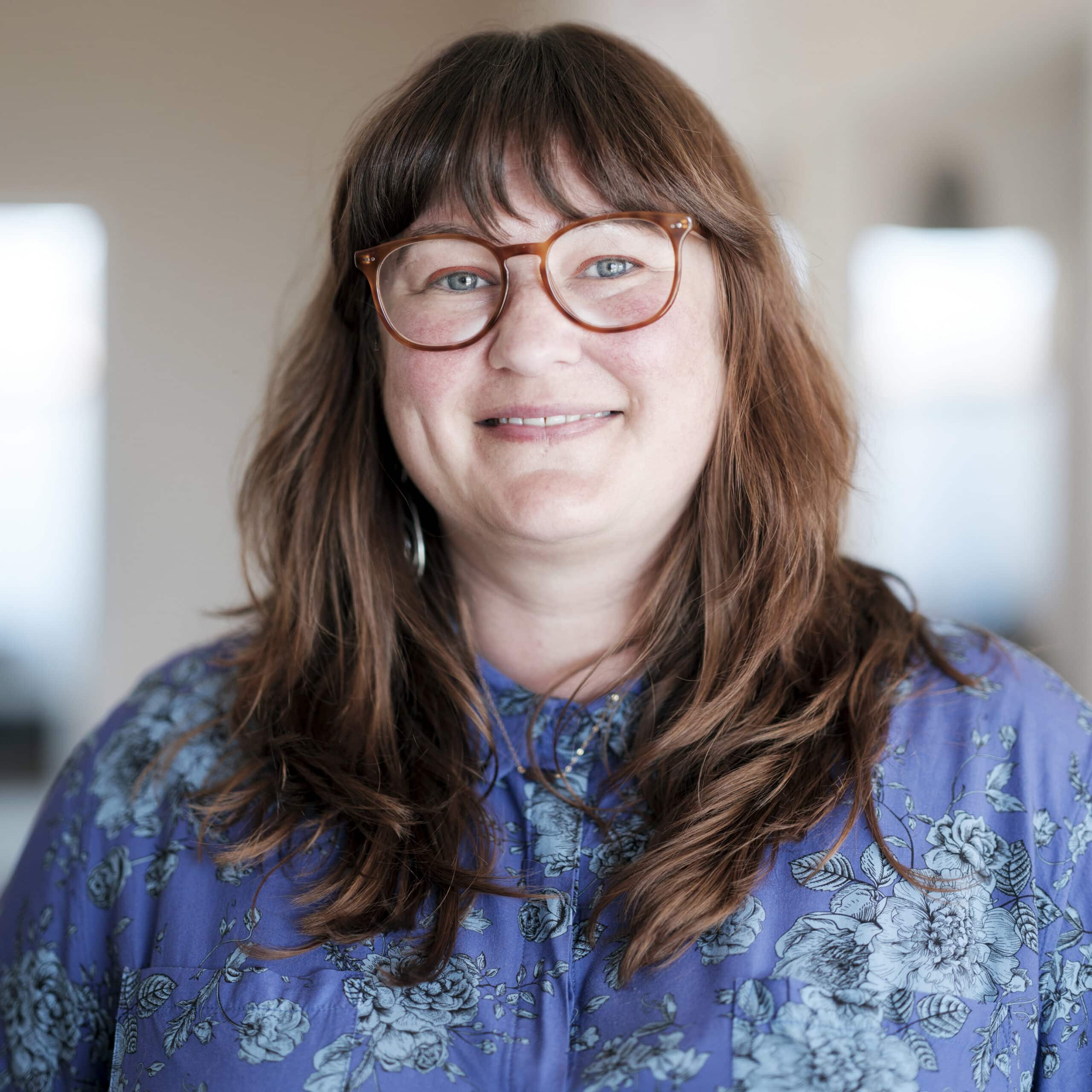
Serena J. Rodriguez ’20 and ’22
Profile
Before graduating, Rodriguez spent two years working as a Learning Lab Specialist at IAIA. “I loved connecting with others, especially in one on one or small group situations. The rapport within these exchanges has felt necessary for personal and communal growth and an understanding of life and learning on a deeper level. This way of learning is something I first realized while attending IAIA. I had assumed college meant overwhelmingly large classes where one had to fight to be heard. However, IAIA showed me otherwise. The intimate and respectful exchanges from these positive learning environments have changed how I view learning,” said Rodriguez. She plans to continue to give back by teaching at IAIA and offering small workshops and writing groups within the IAIA community, where she says that feedback and criticism uplift the writer in a way that inspires them to dig deep into the layers that create magic.
Rodriguez has been working on a new manuscript, while the one she finished this past summer awaits a publisher. “As a woman, mother to a child with extra needs, and a person living with a dis(ability), I am focusing on new material that questions the intersectionality of dis(ability) and gender, and the predetermined constructs that come with this. I hope to have more material on this subject out in the world soon,” says Rodriguez.
When asked about her work, she said, “I have loved words creatively and technically. These different aspects of my career balance my passion for writing, editing, and teaching.”
Rodriguez’s work has been published in Inverted Syntax, Poetry Magazine, The Roadrunner Review, Santa Fe Literary Review, MindWell Poetry, and Prometheus Dreaming.
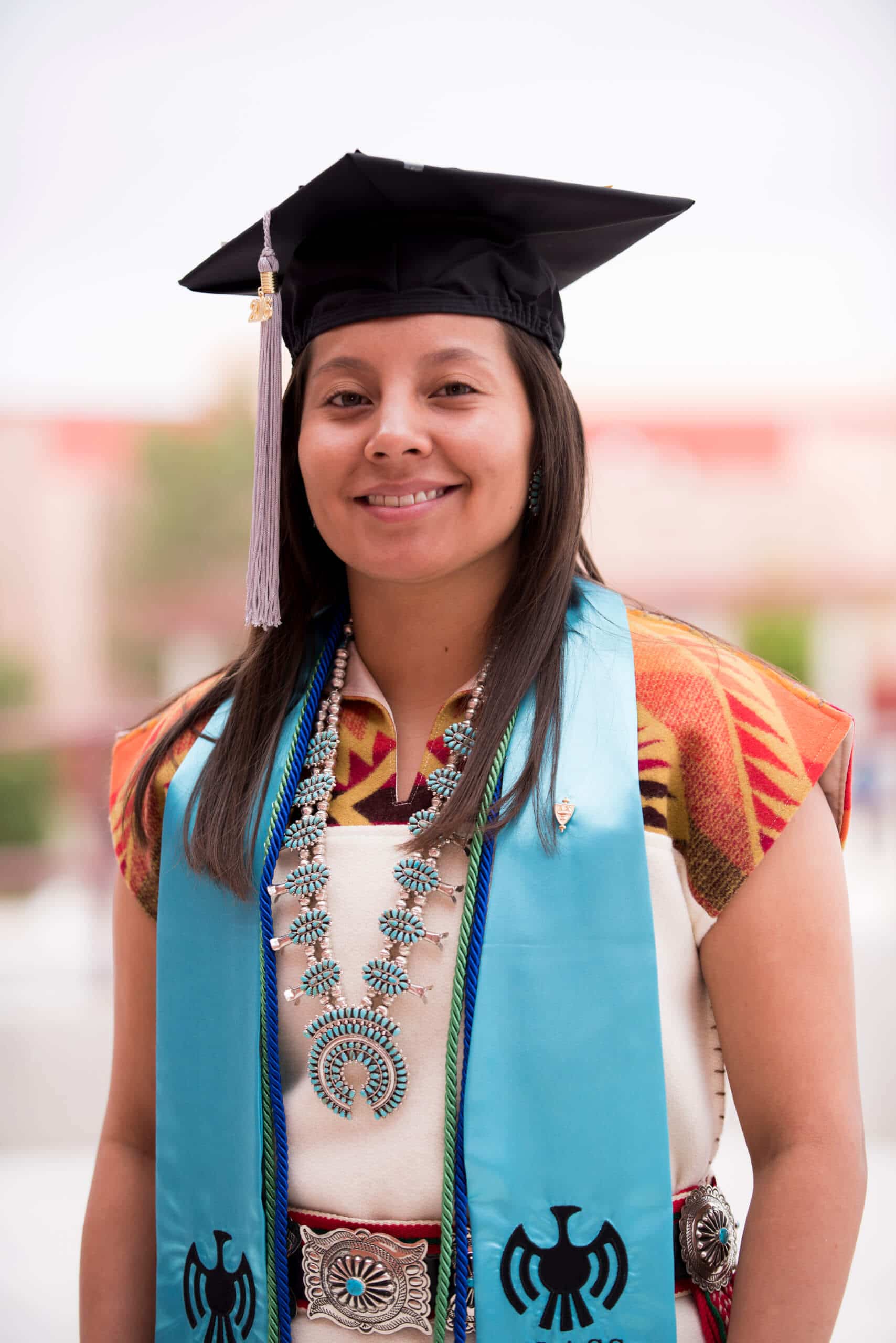
Boderra Joe ’18
(Diné)
Profile
Joe received her BFA in Creative Writing from IAIA in 2016, followed by an MFA in Creative Writing in 2018, majoring in poetry. After graduation, she worked in the Admissions and Community Engagement Department at the New Mexico School for the Arts (NMSA) and the Rio Grande Sun working as a journalist. Most recently, however, she has returned to IAIA as the Program Coordinator for the IAIA MFA in Creative Writing (MFACW) program. Joe is thrilled to be back on campus among the IAIA Community. The new writers emerging from the MFACW are an inspiration for her, and she hopes to use the knowledge and experience she has gained from IAIA to give back to the program.
She credits IAIA with helping transform her both as an artist and an individual finding her voice. The school’s mission was integral in encouraging her to remain connected to her home and culture as she blossomed and learned more about her own identity. Attending IAIA began as a family tradition—her uncle and brother are also alumni—but before she knew it, the IAIA Community became her second family.
Aside from her new role at IAIA, Joe dedicates time to her two passions—writing and photography. Currently, her main focus is to finish her poetry manuscript, Desert Teeth, which will be published in Fall 2022 by Abalone Mountain Press, and to capture the perfect image for the cover. She was recently named among the first cohort for the Indigenous Nations Poets’ (In-Na-Po) Fellows and will attend their inaugural writers retreat in Washington, DC, in April 2022. Joe‘s poetry, articles, and photography have been published in the New Mexico Poetry Anthology, Yellow Medicine Review, Indigenous Goddess Gang, Center for Contemporary Arts, Tribal College Journal, Mass Poetry: The Hard Work of Hope, Gallup Sun, and Rio Grande Sun, and she won second place in “Best Sports Writing” for the New Mexico Press Association’s (NMPA) Better Newspaper Contest. Her photography aims to create “visual poetry,” conceptualizing her work with the written word and capturing it through imagery—primarily through landscapes. Her work will be featured in a photography exhibition at Gallery Hózhó in Albuquerque, New Mexico, in May 2022. Joe also served as an artist in Bosque Redondo Memorial’s Artist in “Their” Residence program in 2021. To view her work, visit her Instagram page at @boethepoet.
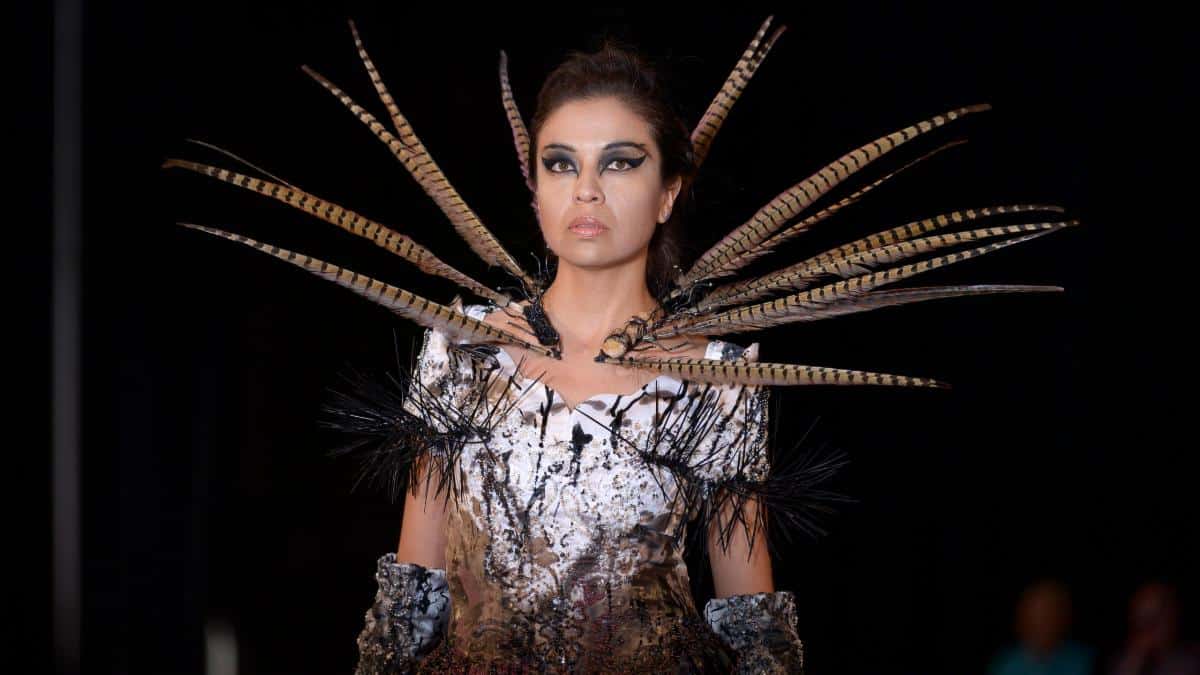
DezBaa’ Henderson ’21
(Diné)
Profile
When Henderson first took an interest in the film industry, she had no idea what her journey had in store. So, as she started auditioning for roles, she took screenwriting and filmmaking classes here and there to learn more about the process. Fast forward five years, and she has an MFA from IAIA’s MFA in Creative Writing (MFACW) program with a double major in Screenwriting and Creative Nonfiction. However, screenwriting is just one piece of the puzzle for her as a storyteller.
Henderson now has a budding film career. In the five years since she began acting on the side, Henderson is now a Screen Actors Guild (SAG) actor. She recently landed her first guest star recurring role on the upcoming AMC television thriller Dark Winds, premiering in 2022. You can also see her in Jesse Eisenberg’s directorial debut, When You Finish Saving The World, starring Julianne Moore and Finn Wolfhard, which premieres virtually at the Sundance Film Festival on January 20, 2022.
Henderson also works behind the camera. After landing a role in a period piece, she voiced concerns about the attire chosen for the Navajo actors—it was not authentic. This experience led to further work as a Costume Stylist and Designer on other productions, including an ad for the Nike N7 Collection and a feature film. Her short film, Wish, was also officially selected for the Emerging Filmmakers Program in the 2021 LA Skins Fest and the Animalis Fabula Film Festival, where it was awarded “Best of the Fest” for Outstanding Short Narrative in January 2021.
Sharing knowledge and education is critical to Henderson as she learns more about the ins and outs of the film industry. She now acts as a mentor for True Kids 1 and Film Prize Jr., nonprofit organizations that make film and media more accessible to the youth. In reconnecting with herself as a storyteller, she wants to aid others in finding their voices again. For Henderson, it’s not about what you can do—it’s about what can’t you do.
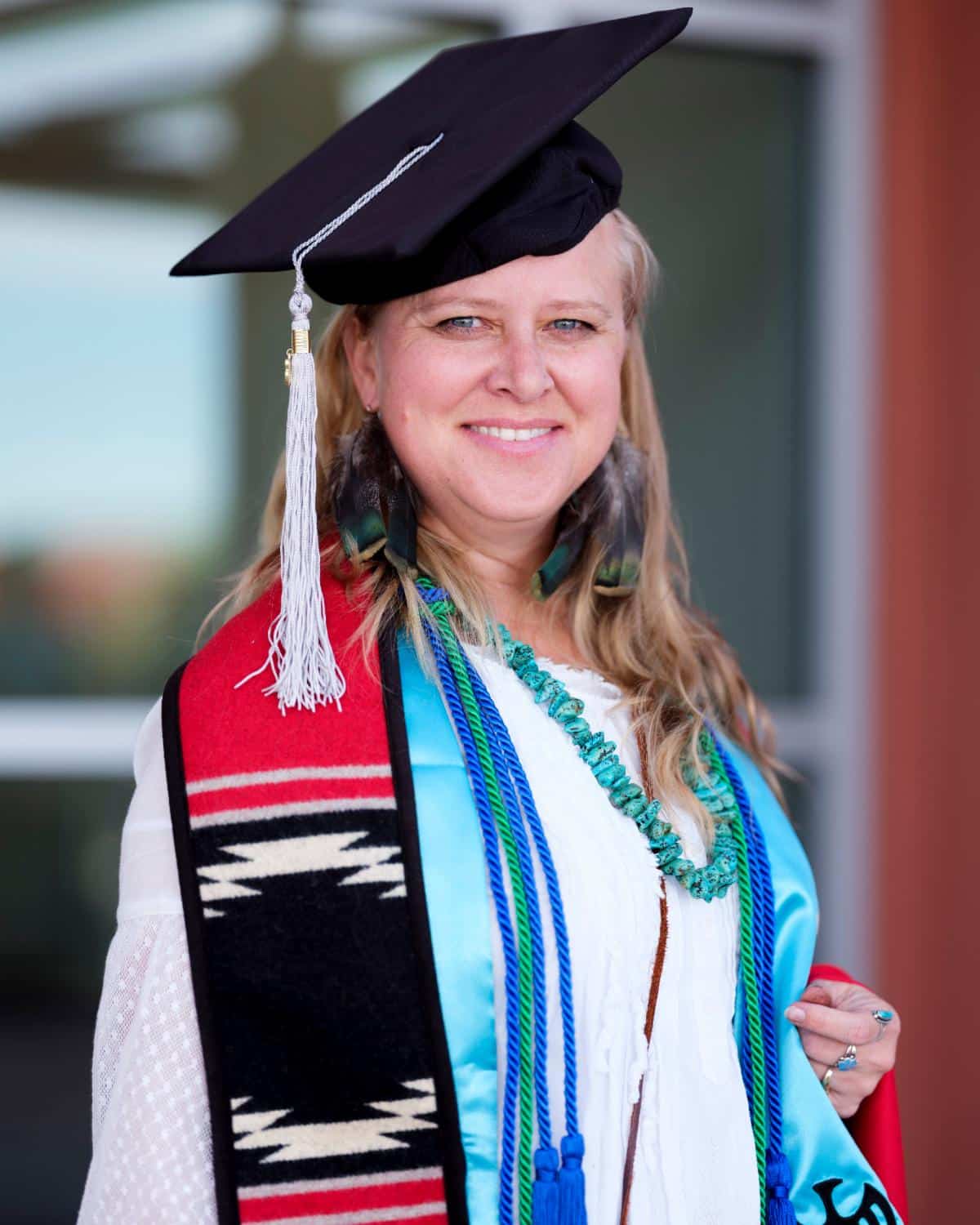
Dr. Elizabeth Kianu Stahmer, DAOM ’18
(Wyandotte, Cherokee, Blackfeet)
Profile
Founded by Game of Thrones creator George R. R. Martin and scientific innovator David Weininger, Stagecoach Foundation is a nonprofit organization based in Santa Fe, New Mexico. The organization brings productions to the state, manages a production building and prop warehouse, develops industry training programs, and creates work opportunities for locals in the booming television and film industry.
As a graduate of the Indigenous Liberal Studies program, Dr. Stahmer credits understanding where you stand and how you engage with other people in a respectful and honorable way as a strong backbone of the program. She believes that the education she received from IAIA helped to prepare her for her current role as Executive Director—engaging with different communities requires integrity, diplomacy, and respect—and she applies this every single day in leading a nonprofit.
Under Stahmer’s leadership, Stagecoach Foundation has developed high-caliber immersive training programs taught by industry leaders that truly mirror what it is like to be on a real set. So much so, that New Mexico IATSE Local 480, the local union chapter of the International Alliance of Theatrical Stage Employees (IATSE) approved these training programs and considers them as work experience. Stagecoach Foundation also recently worked with The WB television series, Roswell, and Stahmer facilitated a season finale event with producers, directors, and New Mexicans who worked on set—which includes IAIA students and alumni.
Stagecoach Foundation provides opportunities for interns and mentees from IAIA and other local schools, and some of these IAIA community members have gone on to start exciting new careers in the film industry. Dr. Stahmer looks forward to continuing to build relationships between Stagecoach Foundation and IAIA and is proud to see IAIA students and alumni gain hands-on experience as they jump into the workforce. Learn more about Stagecoach Foundation and the offered trainings and resources, at www.stagecoachfdn.org.
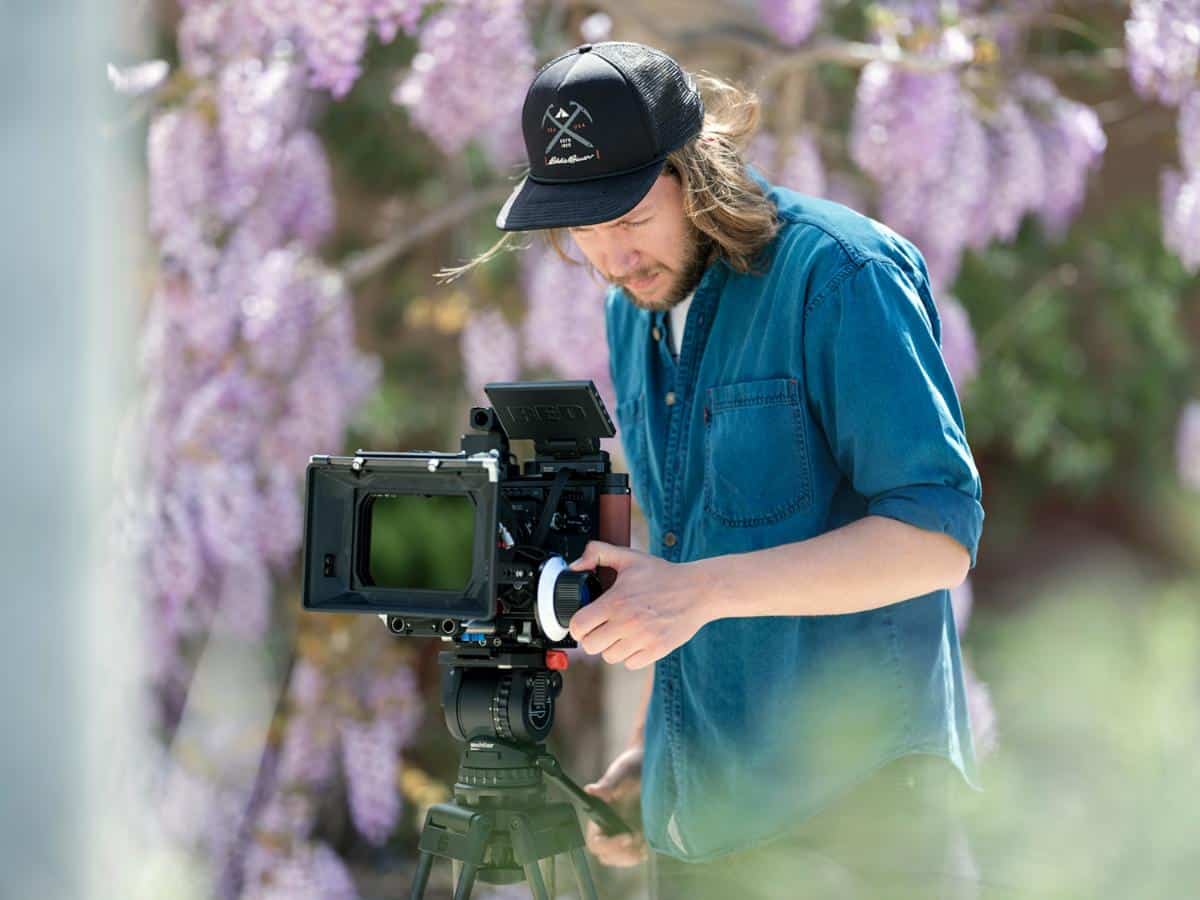
LeRoy Grafe ’19
Profile
Over the past few years, he’s been working on various projects. In 2021, he was the cinematic drone operator for JEEP’s® short documentary and commercial Dark Skies about its new electric vehicle, the Wrangler 4XE.
At the start of the COVID-19 Pandemic in 2020, he served as the Director of Photography (DP) for the New Mexico portion of Ralph Lauren’s® 2020 Holiday commercial. Again serving as DP, he worked on the upcoming YETI short film, The Ballad of Pecos Hank, which follows a storm chaser from Texas to North Dakota. The YETI short film is slated to be released soon.
When Grafe isn’t traveling for cinematic work, he’s at home in Santa Fe with his girlfriend and IAIA Studio Arts graduate Scarlett Cortez ’20.
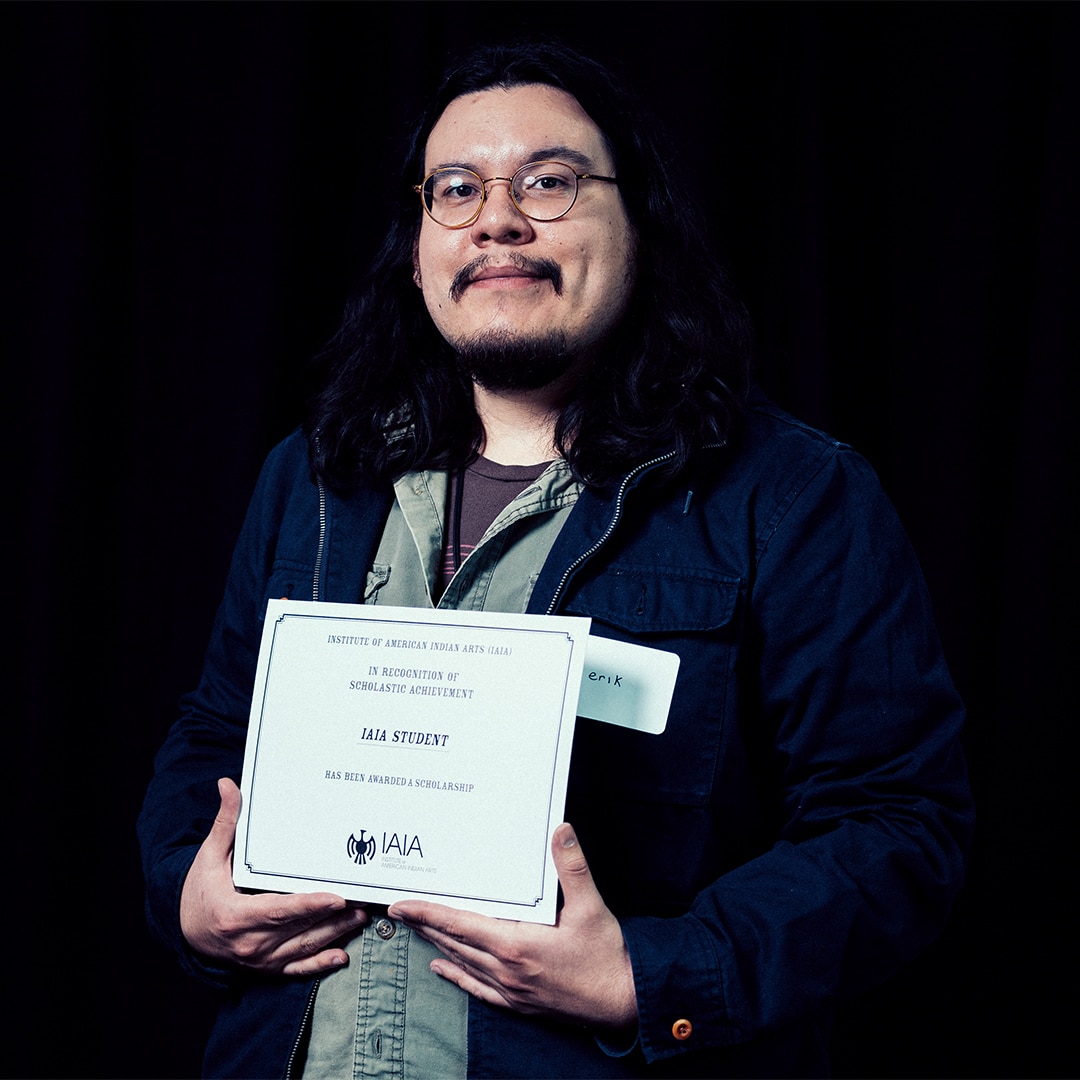
Erik Sanchez ’22
(Shoalwater Bay, Chinook, and Chicano)
Profile
Sanchez’s photographic oeuvre is both conceptual and documentary. “A lot of the stuff I do is street photography, but then I do know how to construct reality in front of the lens,” he says. With his camera in hand, he often comes across surreal vignettes. “I love to capture those odd moments,” he says. “It’s weird. It’s like, it happens, specifically, when I have a camera on me.” Sanchez values the feedback he’s received from submitting his photography to publications. “And one time, I got someone to critique my work back. I didn’t win anything. But the critique was an amazing experience of who they consider I look like or imitate. That was great because I love the reference they gave me.” He has shown work in a variety of exhibitions. For example, Sanchez’s Savage in the Studio (2018) was mentioned by Pasatiempo. Photographs from Savage in the Studio and another series were shown in a traveling exhibition, yəhaw̓, curated by Tracy Rector, which went to museums such as the Shoalwater Bay Heritage Museum and Suquamish Museum. His photographs have been shown at Old Dirty Design, a design firm in Marseille, France, among other localities.
Sanchez’s short films have also received notice, making rounds on the film circuit, and playing at events and exhibitions. Sanchez was included in Rocky Mountain PBS’s Native Lens mini-documentary initiative featuring viewpoints from Indigenous storytellers. The Santa Fe Reporter’s Alex De Vore wrote about Sanchez and his film Sage Me Not in “The Creeps: Filmmaker Erik Sanchez brings horror to the concept of Land Back.” Site Sante Fe included The Last White Man in the Young Curators Exhibition Private Eye, presented digitally in a 3D space during the pandemic. His animation Longhouse was included in the International Institute for Indigenous Resource Management’s Monthly Film Series Quintessentially Indigenous, presented by the Denver Museum of Nature and Science. Recently, Sanchez had two films at the Santa Fe International Film Festival. His senior project, Tyee—Messenger of the Void, was included in the IAIA Student Shorts showcase; the film was a 2023 IAIA Student Filmmaker CINE Award Winner for Outstanding Actor and Outstanding Screenwriting. Frybread Jesus, which also previously played at the IAIA Museum of Contemporary Native Arts, was shown in the New Mexico Shorts 1 program.
Sanchez was surprised by Frybread Jesus’s reception. “I never heard an audience laugh that much, and that blew my mind. And I realized because I started school in 2019—and then the pandemic, right—so I didn’t get my first experience of, here’s my film in front of an audience. Let’s see what happens,’ until later on. So now that I’m getting the full like, ‘Whoa, we’re in a packed theater. This is wild. A lot of eyes are about to watch this.’ I didn’t know how loud the laughter was gonna be. And now, that became something I want to chase. I want to make people laugh. … I’m here to make the world a little bit softer, I guess.”
Sanchez acknowledges his IAIA Cinematic Arts mentors’ contributions to his creative pathway. A sound class with Anthony Dieter (Peepeekisis Cree Nation) first came to mind. “He would assign a project, ‘Okay, find some visuals and add sounds to it, and make it a little Native.’ And I love that. I love how easy and soft he would say that, but that’s what I wanted to hear from my teachers.” Other teachers were also particularly influential. “Lujan, James Lujan—he definitely was the one to show me how much I love screenwriting. Sharon Ross made me feel like my imagination is limitless, and I thank her for just showing me that possibility of how to be a writer. … we had a pretty good bond that whole way through. I thank her a lot for just believing in me.” She provided Sanchez with many resources. “Dude, they’re all great—Khalil. Liam.” It doesn’t stop there. “Now that I think about it—the whole department. Right, just the whole Cinematics department. The fact that they bring Chris Eyre (Cheyenne and Arapaho Tribes) to speak with us and look at our work. That’s huge. I think that was the coolest thing that they did.” While at IAIA, Sanchez also interned with the Stagecoach Foundation in 2021. Sanchez asks, “If you could just put how incredibly grateful I am for being at IA and everything they’ve done for me, that’d be perfect.”
Scholarships proved vital to Sanchez’s success. “So, I’ve been on a tribal scholarship with my tribe since my junior college,” explains Sanchez. The Shoalwater Bay Indian Tribe offers multiple scholarships for their members and helped put Sanchez through school. “It’s a little nerve-wracking when everyone’s like, ‘We all believe in you, Erik.’ And being able to study storytelling of all things, it’s such a huge deal,” he says. “… I know I got my tribe’s back. What am I gonna make?” While at IAIA, Sanchez was awarded the prestigious 2021 George R.R. Martin Master Storyteller Scholarship. When asked how IAIA helped his career, Sanchez responds, “After I got the George R.R. Martin scholarship—dude, that saved me so much time, and like, I didn’t stress out about ‘Am I going to eat? Am I going to pay rent?’ So now that the money situation got taken care of, I was able to dedicate so much time to school, and I’m glad and grateful I did because what I put into it, I got back out. And I met cool people. I got great opportunities and had time to think of funny films to make. Even just saying, ‘Oh, yeah, I go to school at IAIA,’ that opens doors. That put smiles on people’s faces. I’m second generation to come to the school. My uncle went back in ’68, and he’s been trying to get everyone to go, and I’ve been the next one to go. And I’m trying to convince my cousins and my nephew and nieces to go next, because he knows how it helped him. … he said it was the best years of his life. And I agree. This was my first tribal school experience. And I loved it. I loved it so much.”
A full-ride scholarship enabled Erik Sanchez to attend CalArts, where he hoped to study as a youth. “I grew up in the Imperial Valley, Southern California, part-time. It’s like I did the school things here, but then went to the rez for the summers,” he explains. “And I did that for like, up ‘til I was like 15, 16, 17, and by the time I was graduating high school, I knew about Cal Arts because of a TV show called Six Feet Under.” When Sanchez attended a Digital Dome class at IAIA, a guest from CalArts came to visit. And I was like, ‘Whoa, I remember that school.’ So that was a full-circle moment for me. I really wanted to go when I was out of high school, but financially there was absolutely no chance. So when CalArts came to campus, I thought, ‘Is this finally my chance?’ So, I just kept asking everybody—I was like, ‘Hey, what’s CalArts doing here? I want to go to CalArts. How do I go to CalArts?’ And I asked the right people, and then they said they have a scholarship, and I applied for it. And I prayed real hard, and I got in.” There, he is directly learning from experts in the film industry. “We get people who are working professionals come in and talk to us,” he shares. Gina Prince-Bythewood, who recently directed The Woman King, will be visiting CalArts. “I’m excited for that, because I remember Love & Basketball—when that came out.” He is also expanding his education of film history at the school. “Well, I guess this is what I’ve been seeing from CalArts more, CalArts is more like, ‘Hey, have you seen this? No? Let’s watch it right now.’”
Sanchez talks with his former IAIA classmates weekly. “I tell them what I’m learning, and I show them videos that CalArts is showing me,” he notes. “So, I’m just transferring the knowledge. I’m like ‘Hey, have you seen this one? They showed us this today.’ Yeah, we’re all still talking. I definitely built a good crew.” He has them in mind for future collaborations. “When I first got to IAIA, I didn’t know who I was bumping elbows with at school until we finally started making work, making films. And then it became like, ‘Whoa, I can’t believe I’m in the same class with Rayne Kingfisher or Juliana Brown Eyes.’ They make great films. I want them to be my friends; I want them to be part of my crew. You meet really great people at school. And then for me, I just want them to do what they do best on my films. I try not to be like, ‘No, it needs to be 100% my way.’ It’s like, ‘No dude, I picked you because I love your work.’”
The international student body at CalArts has Sanchez thinking about new possibilities. “Because I’m in such an international campus now, I’m not, you know, categorized as a Native filmmaker anymore. Now they’re putting me as an American filmmaker, and that’s trippy.” Noting the diverse student body, he wants to make films that tap into that.
“As a millennial, as a Native American, I have this pressure on my back that I have to save the world. That one’s a hard one. I don’t know how to do it other than tell a story.” Sanchez has climate change stories he would like to tell in the future, and he has a fantasy dramedy in mind about Indigenous global connections. “Oh, this is a new one I’m thinking about—the globalization of America. If I’m an American, and I’m thinking about my international classmates, it’s like, ‘What do you know about America? Do you know about Indians? Oh, you do? All right.’ … So, I’m trying to make this web that wherever America is, that on the globe—which is basically everywhere because of colonization—then all those people around the world know about Indians.” There are still those who could benefit from further education. “I got to travel to France and Turkey. And it’s always like, there’s always a guy who’s like, ‘What are you?’ And I tell them, ‘I’m Native American—Indian.’ And then they, of course, the first thing—’ I thought you’re all dead.’ ‘Surprise!’ So, I know that people in Europe, people in Asia, they have a concept, they know something—there’s something about American Indians there. So, I’m going to play on that. Especially now that there’s actors from all over the world at my school. So, it’s like, ‘Okay, how do I work with this person from Bangladesh?’”
Sanchez notes that his interest in comedy contrasts with a focus on drama films at CalArts. “There’s a preference for the dramatic films, and I’m coming in like, I’m silly, and I’m making comedy. And it’s hard to joke around sometimes. But I think they’re starting to understand that I’m more of a trickster character than whatever they were expecting.” Still, he is open to new experiences. “I want to give drama a shot. I’ll probably do a couple shorts of that. I would love to come out with a pilot episode of a sketch TV show.”
“Talking about the funny things on big subjects, I watched a lot of Michael Guess, and Spinal Tap I was obsessed with as a kid, and anything satirical. I just loved it,” he reveals. “And I was probably too young to really know all the jokes, but I knew something was going on … So that’s the funny thing about satire and comedy, it’s like, well, I could say big things in a funny way. And it’s all about being simple—and that’s what I noticed is, the more simple the joke is, the bigger of an impact it has. And I think IAIA helped me figure out who my audience is, who I want to make films for. And that’s big, because that’s what the whole identity thing is like, ‘What artist am I? Who am I making art for?’”
Sanchez muses, “I keep saying that I’m a mirror, that I’m water, and I reflect a lot of things. And that happens a lot to me on a daily, personal, one-on-one interaction. And I could do it with film too. So, I reflect and show back things that I’ve experienced—a lot of injustices—I feel like a lot of people see me and have their own idea of who I am, and they treat me a certain way because of that. And I’m lucky I’m a funny person; otherwise, I’d be a very angry person.”
Who is Sanchez’s audience? “I’m making art for other Natives,” he asserts. “…I had a teacher tell me that I should make it more accessible to non-Native folks. I was like, ‘I ain’t doing that. It’s not for you.’ So no, I know who I want to make art for, because that’s what I wanted—or that’s what I needed. When I was in a hard place trying to figure out ‘Who am I?’, identity and art really is the way that helped me express myself and helped me figure out who I am.”
“It’s like, recently I heard the more specific something is, the more original it becomes,” he shares. “So it’s like, well, the more specific I get about being Shoalwater Bay and Chinook and Chicano, the more original this art’s going to become.”
Learn more about Erik Sanchez’s work at www.sanchez-creative.com
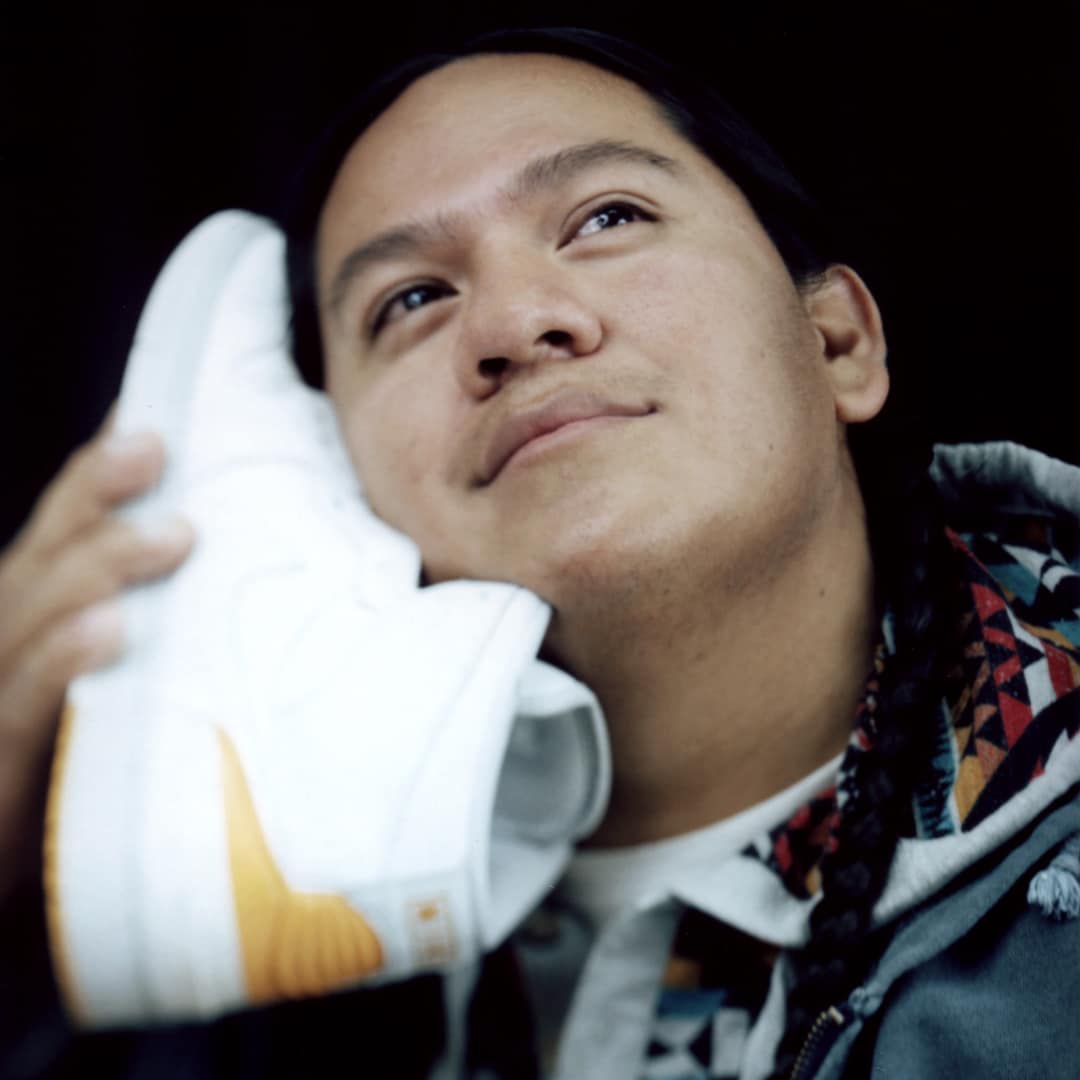
Chad “Little Coyote” Yellowjohn ’19
(Shoshone Bannock, Spokane, and Ho-Chunk)
Profile
Yellowjohn previously attended IAIA in 2009 and, years later, decided to return to campus. “I remember I was working morning shift and a night shift at the UPS airport, and we were just stacking boxes all morning, and then [we’d] come back all night. It was just a repetitive thing. And I remember looking through my phone … just seeing all these Indigenous artists that came from IAIA just doing impactful things in their communities … and I was just like, ‘I want to do something like that.’ And I remember, again, an email the next morning—the following day—and saying that, ‘Congratulations, you’ve been re-admitted to IAIA.’ And I was like, ‘Dang, I’m really doing it, like I’m really going back to IAIA. And so, I always keep that part of my mind, and I’m very thankful for where I’m at. And so, and I think just joining the inspirational row that we’re all on is gonna be impactful for those who may need it. There might be that one kid looking through his phone working at an airport.”
Yellowjohn’s decision to focus on Cinematic Arts as a major comes from making videos with his family. “Well, when I was a kid, I remember when my nephews were about 4 or 5—wait, 5 and 7—we would just like—I would just say, I have this idea, and it was more just like, using the camera, then pressing the pause button, and then going over here, pause, pause, and I worked on little editing projects, and I made like a few karate fight videos with my brother. And my brother Shanner, he pushed me towards that way because he was saying, like, ‘Art is always gonna be a part of your life, and I think you would be cool if you went into cinema.’” Cinematic Arts allowed him to reformulate some of his ideas as well. “And there’s a lot of value that I got from that situation, or from that experience because I have all these stories in my head, but to put them in a script form is very helpful, and also, it inspires me.” Yellowjohn says that Cinematic Arts “helped me draw out this one story” that he plans to turn into a children’s book, featuring a Native boy and his dog, which originally came to him in a dream. “To put it in story form, it wouldn’t have happened if I didn’t take cinema,” he says.
While Yellowjohn worked at the Poeh Cultural Center creating marketing materials, at the time, he hadn’t yet applied digital tools to create illustrations. He once held the opinion that digital artwork was “sort of cheating.” “And so, when I took a digital art class, I was stressing out so much. I was like, ‘Oh, my gosh!’ ‘Oh, the wrong layer!’ or ‘Oh, my gosh! Like how do you—how do I get this?’ … And so, I was like, no, digital is not the easy way out.” While Yellowjohn works digitally extensively these days, he appreciates drawing traditionally. “But yeah, if I had to choose one, I definitely would choose hand-drawn, just because there’s teachable moments in it. With markers, there’s no going back, like you can’t just erase or put white-out. You could use white-out, but just won’t look the same.” He sees the process as “a life lesson.” “Once you mess up, you can either work with the problem or just get rid of it. And I don’t like to do that because I think all of us artists think the same way, like that piece has a life to it. It needs—No, no. I would feel guilty about just throwing it away if I just messed up. And so, just like in life, you can work with your problems and figure it out.”
His time interacting with a diverse intertribal community at IAIA enhanced his creativity. “…when you go there, it’s like more of like a big collaborative,” shared Yellowjohn. “It’s like [an] Intertribal chapter in your life. You’re picking up certain techniques or certain outlooks or certain perspectives from the students are attending IAIA, and you’re gonna share yours. And from where I’m from, there’s not a whole ton of two-spirited people. And when I arrived to IAIA, just seeing that, their free spirit has impacted me in a way to where I can be more expressive about myself as an artist, and especially being more expressive when it comes to Indigenous issues, and also going to Standing Rock too, with the group of students was a big impact on me, too, because, like there’s a bigger picture.” He is also happy to see the success of other creatives. “And also still, a day like when I run into you or run to any of the other artists, we’re all doing our own thing, and I see it as like us climbing up on top of this endless mountain … we’re all on our own path. We’re all taking different trails. They’re all gonna have their own obstacles. And so, I always just tell people, ‘Just promise that I’ll meet you at the top.’”
After graduation, Yellowjohn was commissioned to create a series of caricatures of artists featured in the Wheelwright Museum of the American Indian’s exhibition Laughter and Resilience: Humor in Native American Art. The portraits were on display from November 10, 2019, to March 7, 2021. Ben Calabaza (Tewa), a former IAIA staff member who was then at the Wheelwright, recommended and presented Yellowjohn’s work to the exhibition committee. Yellowjohn “had this other idea of just collaborating with their style” and incorporated aspects of “that style into their portrait.” “It was just— that was my first time to really meet those artists, cause there’s a few of them I have never met. And so, I was really excited. I was really thankful for Ben to give me the opportunity,” says Yellowjohn.
Yellowjohn was also chosen as the 2021 IAIA Molly of Denali Fellow with WGBH/PBS. For “Homemade Heroes,” the first episode of season three, which aired the following year, he designed the superhero outfits for the characters Molly, Tooey, Oscar, and Vera, and the Denali Defender, which was “one of my highlights on my life, because I remember my nieces and my nephews like they watch it.” He worked with Sydney Isaacs (Tlingit), who was the inaugural Molly of Denali Fellow. “I remember she was telling me that we both went head-to-head to take the opportunity that she’s in, and she got it, and she was the best one to be chosen for the opportunity, of course. And so, when I applied again, got it, and it was just really cool to be under her wing, and also just seeing how, in that area of work, how she’s involved, and also how careful she is, and when it comes to cultural detail.” Isaacs advocated for Yellowjohn. “I remember we were in a meeting, and they were talking about having a superhero episode … It’s almost kinda like it was Sydney; just kinda opened the door for me in that area. [She] just said, ‘Chad knows how to draw.’”
During the pandemic closures, Yellowjohn began developing a series, Masked Dancers. “Markets were getting shut down. Powwow ceremonies were being canceled, and so I had nothing to do. And so, I remember just motivating myself to dance … So, I did this sketch of myself dancing, and it was motivating … I posted it, and I got a lot of likes from it. And so, I was just like, this is kinda fun! And so, I drew my sister, drew my mom, and I drew my uncle—drew my cousin, and then it slowly, just branched off into these different cultures and different backgrounds.” He created 25 illustrations of dancers from a variety of Native North American and other Indigenous cultures, such as a Navajo basket dancer, a powwow fancy dancer, a Pueblo buffalo dancer, a Yaqui dancer, and a Woman Calpulli Dancer. Some illustrations depict IAIA alumni, such as a Shell Shaker Dancer based on Faithlyn Seawright (Chickasaw, Choctaw) ’21 and a Yup’ik Dancer based on Golga Oscar (Yup’ik) ’20. The illustrations also include a Samoan fire dancer, a Hawaiian Hula dancer, and a Tonga dancer, which speaks to friendships with and familial connections to Polynesian peoples. His “sister cousin” NaTika Leuluai (Shoshone Bannock) married a Samoan man, with whom she has three children. Yellowjohn also went to school with Polynesian classmates, had a Polynesian roommate, and created shoe designs for Polynesian friends and friends of friends. “I painted on shoes, but I never thought I’d do Polynesian art on shoes.” A “favorite chapter” of his was “just learning about what the shapes mean.”
The Masked Dancers series culminated in his first solo show, Masked Preservation, at the Spokane Falls Community College Fine Art Gallery in Spokane, Washington, from September 22 to October 25. KXLY 4 News Now invited the public to the reception, featuring Yellowjohn on the segment as well as his niece and nephews Makli, Sisnce, and Sabine BrownEagle-Branson, who danced in regalia. Masked Preservation was the first time Yellowjohn’s family got to see his work in an exhibition. “And so, just to have my own show and have my family attend was awesome,” Members from both his father’s and mother’s sides of the family danced at the opening, including his nephew Sabine BrownEagle-Branson and his “sister-cousin” Nakita Leuluai, who “was recently diagnosed with MS [multiple sclerosis.” “But yeah, NaTika Leuluai—she dusted off her old jingle dress … It was just very inspiring to see her in her regalia,” said Yellowjohn. “And also, she was one of the first five dancers that I made out of that Masked Dancers series. And so that was really cool—is just—and to have your sister cousin to just come back out of retirement to just come and dance for you.”
During the opening, Yellowjohn became emotional, thanking his family, particularly his mother, which led to a humorous moment. “I turn around back to the crowd, and I was like, ‘I wanted to thank you guys for attending. Please enjoy the show.’ And right before I was about to end it, my mom yells, ‘Thank your brother! … everyone just looked at my mom …. so I looked at my brother. He’s behind a tree, taking photos. I was like, ‘Thank you Shanner, thank you for…’—and the only thing that popped up my mind—I was all like, ‘Thank you for drawing bunnies when I was a kid, cause it made me want bunnies,’ and then the crowd, the applause, was not that great. Yeah. And then my brother comes out like, ‘That’s me!’ that everyone just started clapping again.”
Yellowjohn will undertake his first artist residency at IAIA from October 18–November 15, 2023. On his way back home from a trip, he decided to apply to the A-i-R program after seeing a “last chance” email. He plans to work on some large-scale panel pieces depicting dancers and experiment with animation. In preparation, he has been working on a large hand-drawn depiction of a Native man braiding his hair, a reinterpretation of a past favorite work, to see how long it takes to complete a piece. The choice to work with markers more for the residency is intentional. “And it’s very therapeutic, too. And I spend so much time on digital. And I was telling my friend this, and I was like zooming out on the paper, and you can’t do that,” he smiles. He plans to scan the works and make the dancers move using Adobe Premier, which he originally learned at IAIA to, as he says, “put motion to my art.”
Be sure to keep up with Yellowjohn’s creative adventures on his Instagram account @lil_coyote and website www.littlecoyote.com.
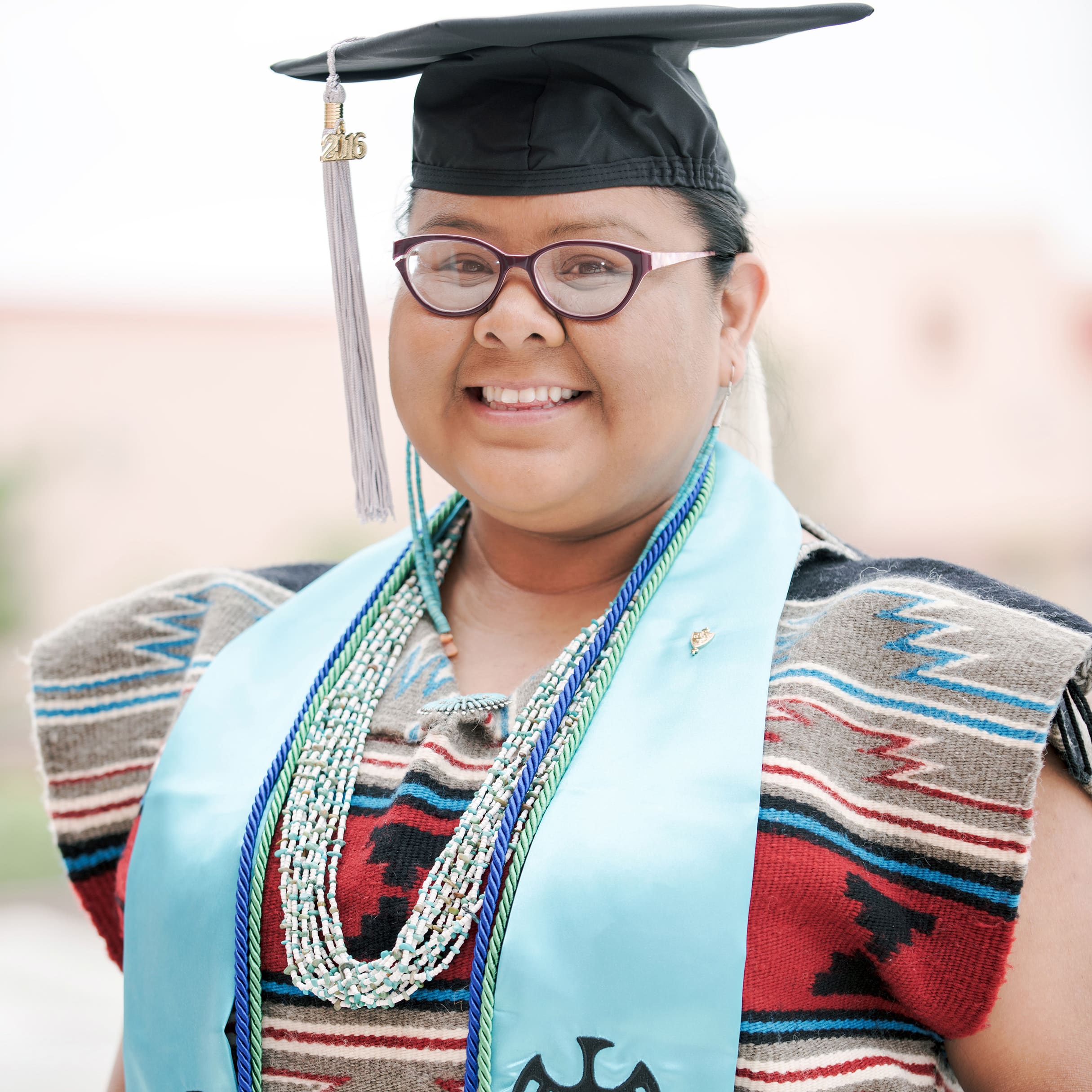
Alberta Nells ’14 and ’16
(Navajo Nation)
Profile
While at IAIA, she worked as a Student Success Center Aid, a Library Aid, and a Navajo Language Tutor for a Santa Fe Indian School dual credit course. After graduating from IAIA, she took a year off to be with her family in Arizona. She worked at the Museum of Northern Arizona, where she previously completed a Development Department Internship as an IAIA student. She worked in visitor services, served as a Diné Language Discovery Camp Assistant, and contributed to developing the museum’s ethnology gallery. “So, I was part of that—with helping to review certain material, content, doing a few lecture series with the docents, also getting to do a video introduction project with some of the other tribal members within the region,” Nells explains.
She also studied at the University of Oklahoma’s master’s program in Indigenous Peoples Law for a year before returning home in anticipation of the birth of her son and ceremonial commitments for the first year of his life. Nells now lives in Flagstaff, Arizona, where she began teaching at the STAR School when her son was six months old.
“I’m wrapping up my fourth year and will soon be starting my fifth year teaching here,” Nells notes. At the school, the students are predominantly Indigenous. “We’re about maybe five miles from the reservation line,” she says. “So, the majority of our students are bussed in from the local communities on the reservation and also from Flagstaff.” She teaches as an Enrichment Instructor for Grades 1–8, covering reading literacy, phonemic awareness, and a Middle School Indigenous Reading Circle; a Service Community Instructor for Grades 6–8, teaching community awareness, Indigenous research methodology, and community-based projects; and a Social Studies Instructor for Grades 6–7, teaching world, Indigenous, and United States history, United States and Tribal civics, and world, United States, and Tribal geography. Nells also serves as Art Instructor for Grades 4–8, a position she was offered due to her IAIA background.
“…it feels like everything that I developed, I came full circle,” shares Nells. “And I just owe so much to the college, and what it taught me, and the skills I developed there, and to bring it here, and to have my own students tell me that they want to go to school there in the future and that they know that there [are] tribal colleges and that college is attainable to them through these opportunities.” Nell’s passion for encouraging Native students extends through the years—since 2015, Nells has served as a student ambassador for the American Indian College Fund, and in 2021, she also taught as a College 101 Instructor for Northern Arizona University’s Nizhoni Academy.
For the art classes, Nells focuses on centering Indigenous art and artists. “I was like, ‘While you’re here with me, we’re going to learn about who Allan Houser is. We’re going to learn about Oscar Howe. We’re going to learn about these different mediums and these different people. We’re going to do a section on ledger art and how that ties into history,’” she shares. “So really taking those things, and really identifying it as ourselves and our own intellectual property, and how we protect it, and how we express ourselves through it. And it’s just like the cutest thing to see, and just the way how they connect all these different things. I’m like, ‘All right. This is a picture—Indigenize it.’ Or, ‘Here’s a superhero. How do you Indigenize it?’ So really, just like incorporating all these different concepts and knowing that we have our own artists out there that lead this way.” Nell’s own father, a silversmith and stay-at-home dad, brought her to art shows when she was growing up. “And so, a lot of my artistic influence comes from him and what he exposed us to. And I tell my students, you know, it’s possible. It’s possible to just be a self-sufficient artist. It’s a lot of work, but it’s how my dad raised me. And so, just knowing that’s an option too, to be a full-time artist and practicing. You know your culture through your art, and how that can sustain you, and how you take care of it, and how it’s very precious.”
Cultural sensitivity is a priority for Nells and builds on her work at IAIA. “I think one of the really like, ‘Aha!’ moments that I had was when I was doing my senior project in ILS. I did it based on the needs of having cultural sensitivity and awareness training, and the need for that in institutions.” At the STAR School, another staff member working on a dissertation on professional learning communities led to the development of a Culturally Responsive Team. “And so, we started up different committees, and one of the committees that I was put on was being culturally relevant,” explains Nells. “We started working on how we can integrate a lot of our non-Native staff into being part of our community, especially since we serve—about 99% of our students are Indigenous—are Native. How is it that we create a safe space for our students by involving our non-Native staff? And so, going back to my senior project being that, and to be able to practice that here with the staff, it came full circle in that way.”
Nells emphasizes the need to be mindful of Native students in the child welfare system and “educating our non-Native staff on what ICWA (Indian Child Welfare Act) is, the threat to it, and why when we do our scanning process, that we implement that policy, and that we’re aware of it and those procedures, especially for our students, that whether they’re on the reservation or off the reservation, that we apply these different laws and policies that are specific to our Native students.”
“So for me, I attended the public school system off-reservation,” Nells shares. “And there are times when I was exposed to things I shouldn’t have been, and being only one or two Native students in the classroom, it was always just that, ‘Oh, well, you need a note for that,’ or ‘You know, we can’t change everything to accommodate you.’” Nell’s treatment as a young Native student and observation of how the inconsideration of adults impacted other Native students and their families motivates her to advocate for Native children. She prioritizes their spiritual and cultural wellness and strives to make “content relevant to them.” “You see when we connect cultures, when we connect content, when we’re learning about different areas, and they’re just like ‘Oh!’ They’re just, ‘They’re Indigenous like me,’’ she said, noting the parallels the children see in grandparents and ways of living “across the world.”
Diné culture is integrated into the classrooms. “K’é is a big one—that’s our kinship, how we relate by clan,” Nells explains. “And so, I have students, you know, they don’t say, ‘Miss Alberta,’ they’ll be ‘Oh, Shiadí,’ you know, big sister, or auntie, or mom, or grandma, granddaughter—however we’re related. They utilize those kinship terms, and so it creates a different level of respect. And then sometimes, it’s just being able to hear it from someone who looks like them, and to know that there’s someone that has gone off, seen the world in different spaces, different people, and to come home and to be with them to share that. Then, when they create their own livelihood, and they make their own journey, so like, ‘Okay,’ you know. It’s possible. We can do this.”
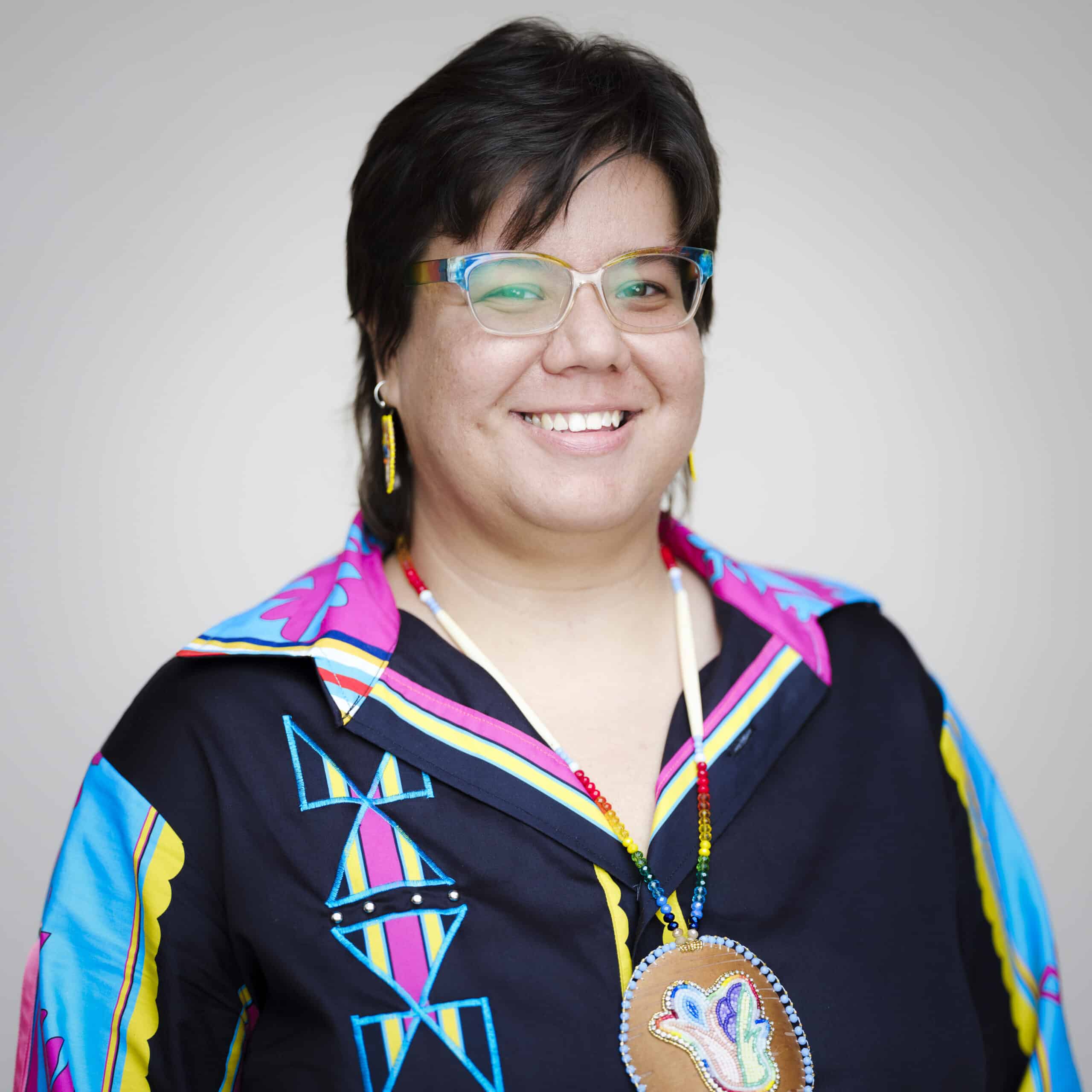
Neebinnaukzhik Southall ’19
(Chippewas of Rama First Nation)
Profile
Southall began taking a certificate part-time in Native American Art History from the Institute of American Indian Arts while working as the Public Relations and Web Coordinator at the Wheelwright Museum, which improved their understanding of other Indigenous cultures and helped them be a better writer and advocate. An independent study writing project with Dr. Lara Evans (Cherokee) led to several A-i-R artist features on IAIA’s website. In 2019, Southall graduated from IAIA and was selected to participate in the Peabody Essex Museum’s Native American Fellowship Program. “Two of my teachers at IAIA, Dr. Porter Swentzell (Santa Clara Pueblo) and IAIA Archivist Ryan Flahive, wrote recommendation letters for me when I applied to the program,” shares Southall. “I’m grateful for their support to further my career. Being a fellow at the Peabody Essex Museum changed my life, personally, and professionally.”
Southall has promoted Native design, arts, and cultures over the years through various jobs and their small creative business Neebin Studios, and they are also a practicing artist. Recent design and illustration clients have included the First Americans Museum, the Coalition to Stop Violence against Native Women, CreativeMornings, the National Indigenous Women’s Resource Center, the New Mexico Department of Cultural Affairs, POETRY Magazine, the Ralph T. Coe Center for the Arts, and SWAIA Santa Fe Indian Market, among others. As the 2021 Eric and Barbara Dobkin Native Artist Fellow at the School for Advanced Research (SAR) and the 2017 Winter Nigig Visiting Artist in Residence at OCAD University, they created culturally relevant graphics for Anishinaabe and other Native communities. Southall has raised the visibility of Native graphic designers through their Native Graphic Design Project designer list and through talks and interviews with platforms such as Native America Calling, Native Talk Arizona, AIGA, PRINT Magazine’s “The Daily Heller,” Letterform Archive, Communication Arts, Typographica, and Portland Design Week. In 2022, they co-curated Ezhishin, the first conference to focus on Native North American typography, in collaboration with the Type Directors Club.
Neebin has written for Hyperallergic.com, the Santa Fe New Mexican, the Santa Fean, the Peabody Essex Museum’s Connections magazine, Letterform Archive, and Butch is Not a Dirty Word. They are a long-time contributor to First American Art Magazine, since its launch in 2013. They recently worked with IAIA on two freelance editing projects, namely the upcoming publications Experimental exPRESSion: Printmaking @ IAIA, 1963–1980 and The Moving Land: 60 Years of Art by Linda Lomahaftewa (Hopi and Choctaw). On March 13, 2023, they joined the staff at IAIA as the Writer in the Communications Department. “I’m excited to be immersed in IAIA again and to bring my skills to a community that has been grounding for me,” says Southall. “I can’t wait to meet and promote all the talented and hardworking people who come through IAIA’s doors—whether students, staff, faculty, or visiting artists.”
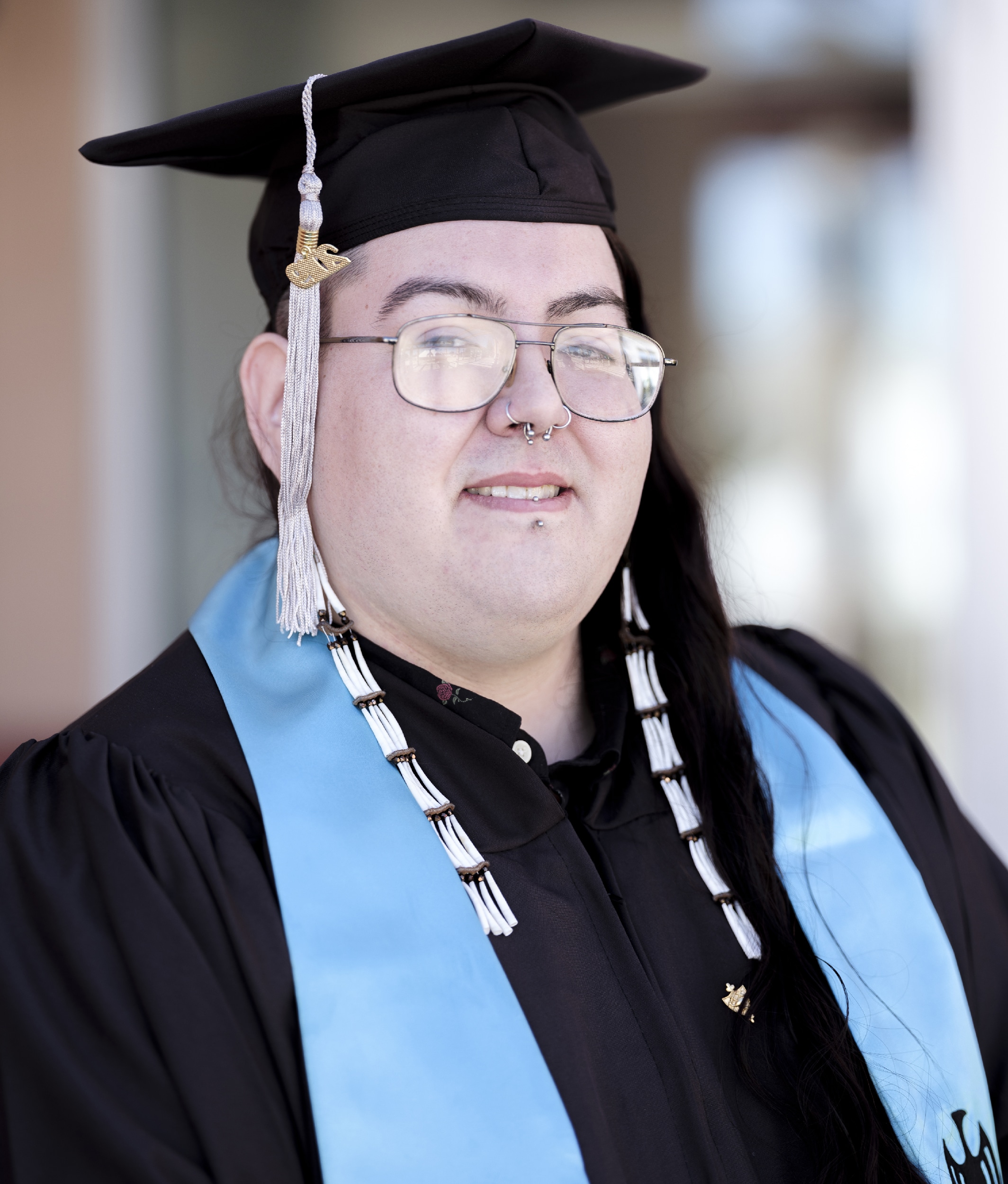
Ryan Young ’19
(Lac du Flambeau Ojibwe)
Profile
Young started their university education in their home state of Wisconsin but before long decided to transfer to IAIA, where they established an interdisciplinary art practice across photography, digital art, and performance. As a student, they emerged as a leader. In addition to their coursework, they advocated for their LGBTQ2S+ peers, and their efforts were the catalyst for IAIA’s first Pride Week.
Since graduating with a BFA in Photography and a certificate in Performing Arts, Young has been paying forward the intellectual, creative, and personal support they found at IAIA. They have worked in outreach and service coordination with nonprofit organizations helping homeless and LGBTQ2S+ youth, and others gain access to the resources they need to empower themselves and become independent. Additionally, they contributed to Indigenizing Love: A Toolkit for Native Youth to Build Inclusion and spoke before the Smithsonian National Museum of the American Indian.
Soon, Young will be offering their wisdom and compassion to IAIA students as the new Student Success Advisor. “I’m so excited to get back to that energy and space. I felt rejuvenated when I was on campus a couple of weeks ago,” they say, referring to their March presentation at the Indigenizing Love Community Gathering.
While Young has been working to uplift others, they have continued pursuing their artistic practice with witty and empowering designs that sharply critique colonial narratives by combining historical photography, pop-culture references, and sardonic quips. “I make work for my Two-Spirit audience. I’m trying to build up my community,” they say. Young’s designs are printed on posters, stickers, t-shirts, and totes, available through their online store.
Young has ideas for new artistic projects, but they are keeping them confidential for now. Young hopes that returning to campus and having access to IAIA’s resources will invigorate their creative energy and lead to new, exciting work as an interdisciplinary artist, a member of the IAIA staff, and a cherished member of the IAIA community.
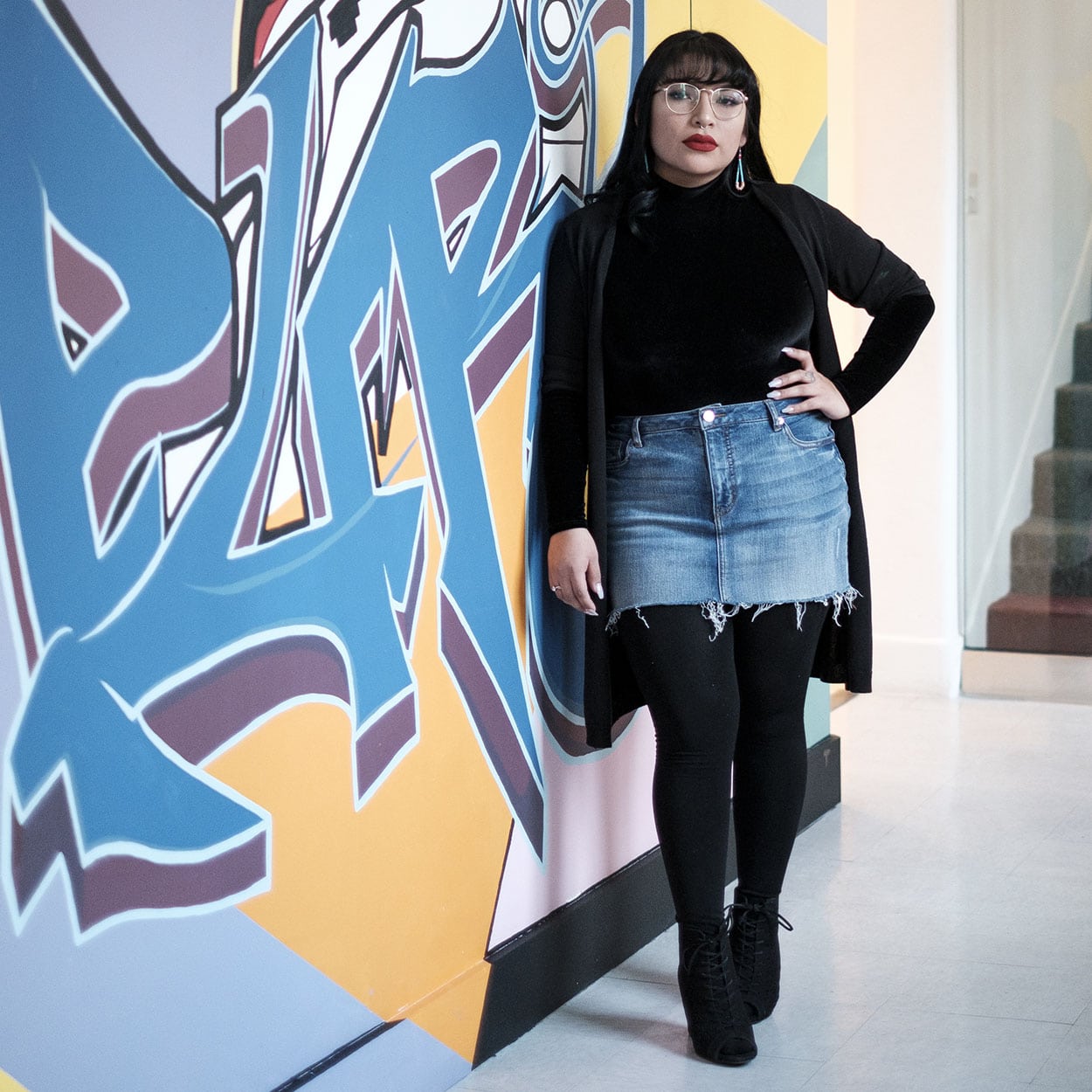
Robyn Tsinnajinnie ’20
(Diné)
Profile
Tsinnajinnie graduated in 2020 at the beginning of the COVID-19 pandemic, and while she felt excited that she earned her degree from IAIA, it was bittersweet because she couldn’t celebrate the momentous occasion with anyone due to the restrictions imposed by the pandemic. Tsinnajinnie, who is from Torreon, New Mexico, a small town near Chaco Canyon, says that earning a high school degree is a big achievement back on her reservation. “I’m proud to have earned my college degree, and I know that it is encouraging for other members of my community,” says Tsinnajinnie. “My favorite part of being at IAIA is the relationships with my peers and the faculty and staff. I got to work with artists in totally different mediums and disciplines. Those experiences have helped me feel more comfortable connecting with people.”
She’s been working in MoCNA’s Collections on campus for over three years, first as a student-worker and now as a part-time employee. “Working with Curator of Collections Tatiana Lomahaftewa-Singer (Hopi/Choctaw) has opened a lot of opportunities for me.” Her second job is one such opportunity, where she works part-time as a conservation assistant with Steven Prins and Company, a Santa Fe art conservation studio. “I get to fix canvases, stretcher bars, and currently, I am repairing an old fresco painting on stone. I also get to ‘in-paint’ sections of paintings where the paint is completely missing, and that’s a lot of fun.”
Her third job, arguably her most important, is her career as a painter. She’s been hard at work since 2020, working on her art. “I’ve been shacked up in my house, painting non-stop, and I’ve been building up an inventory. If I’m not working my first and second jobs, honestly, I am just working at home painting up a storm.”
You can see her work in-person at MoCNA in the mural exhibition Robyn Tsinnajinnie and Austin Big Crow: The Holy Trinity through December 31, the Harwood Art Center in Albuquerque, New Mexico, in ENCOMPASS: A Multi-Generational Art Event, March 7–April 14, and K Art Gallery in Buffalo, New York, in their Emerging Artists series, starting March 18. Can’t wait to see her work? Visit her Instagram page.
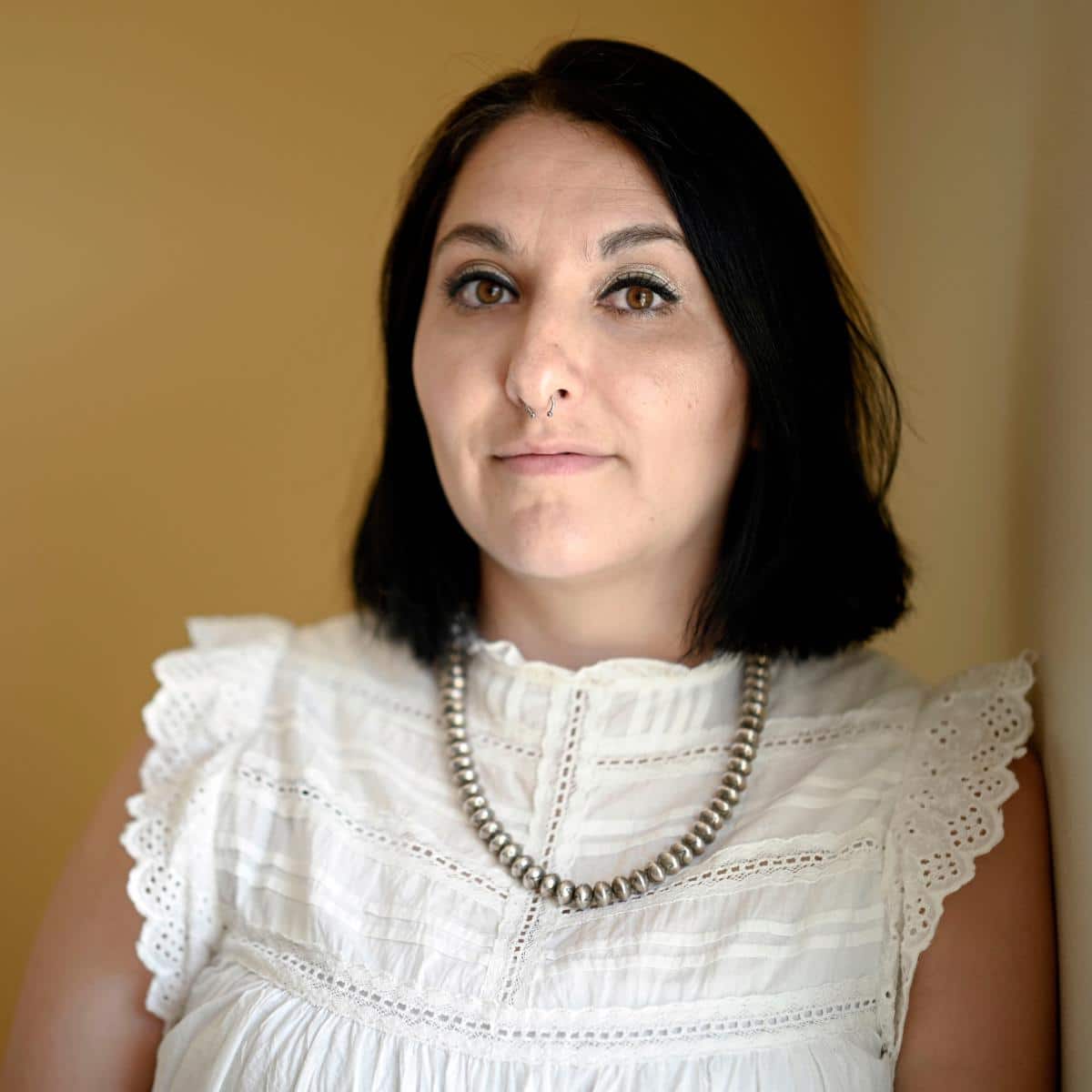
Angelica Gallegos ’15
(Chicana)
Profile
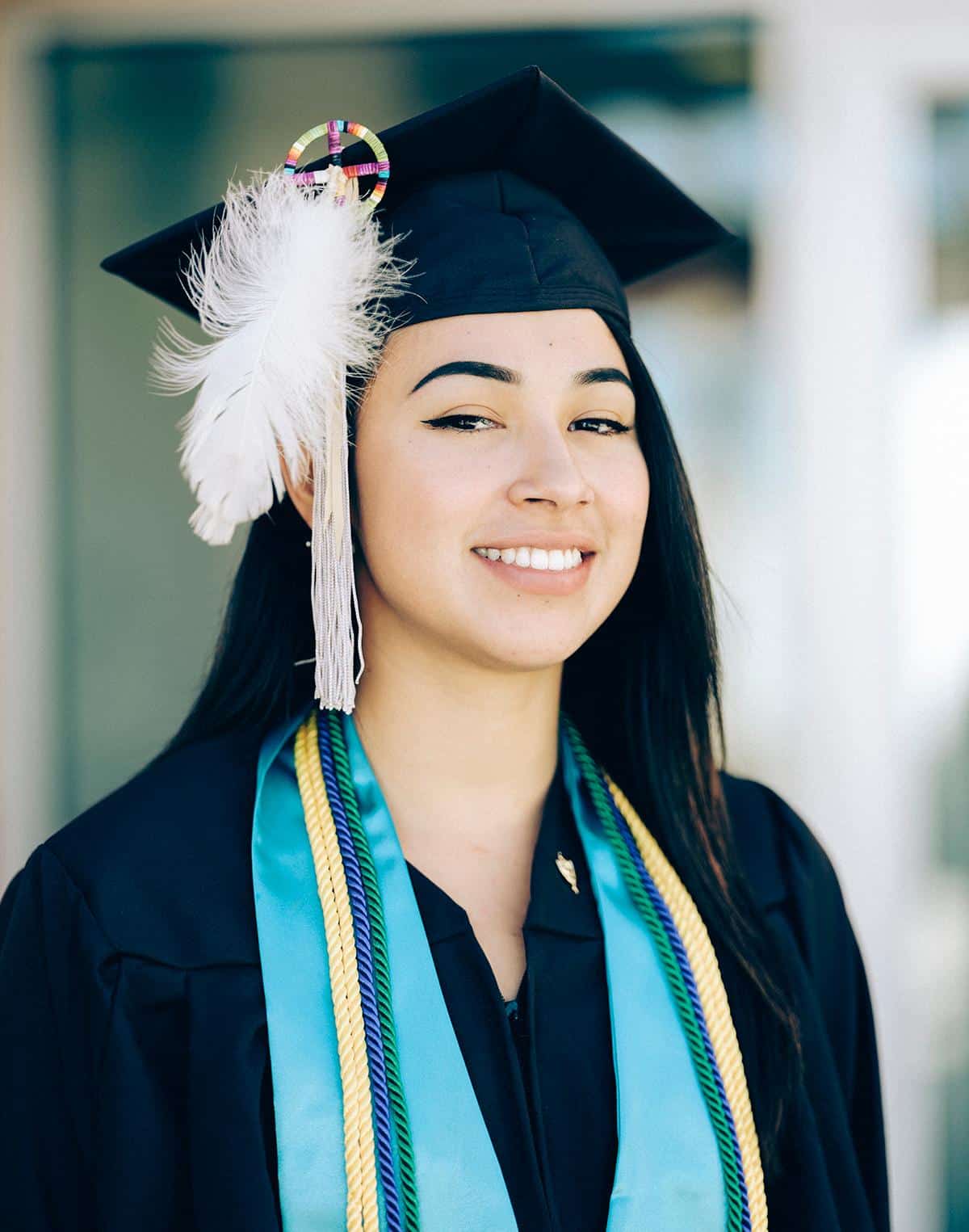
LaShawn Medicine Horn ’19
(Yankton Sioux)
Profile
A studio arts major whose primary area of study was mixed media and installation work, she set out to expand her abstract paintings to new mediums, and the human canvas presented an exciting new challenge. Her studio arts background and education serve as a solid foundation that directly translates to her career in the tattoo industry—examples of both are available on her online portfolio on Instagram.
As she further evolves as a tattoo artist, her goal is to continue to merge her fine arts training with this centuries-old art form. She aims to take up space via exhibitions and pop-ups in institutions where tattoos have not traditionally been considered fine art.
Medicine Horn works out of The Dungeon Tattoo and Piercing in Santa Fe, New Mexico, where she is available for appointments.

Vivian Carroll ’20
(Cherokee)
Profile
Give Back
Contributions, beit sharing your time, expertise, art, or donation, ensures the success of IAIA’s students and its community.
- Time—Committing time as a volunteer at one of the many IAIA happenings helps enrich the campus and also makes for a successful event. Whether it be at the annual Powwow, Winter Art Market, or Commencement, we welcome your help. Please let us know how you would like to share your time with us.
- Expertise—With life come experience, with experience comes knowledge. Please consider sharing your expertise through a workshop, teaching a continuing education course, speaking on a panel, demonstrating skills to our students, or perhaps you have expertise in another area that is not mentioned. We’d love to have you share your knowledge with the IAIA community.
- Art—As an art school, we always love receiving artwork from IAIA Alumni, work that we show in annual IAIA Scholarship Dinner and Auction, at the IAIA Museum of Contemporary Native Arts (MoCNA), the Balzer Contemporary Edge Gallery, or in the IAIA Library.
- Donation—IAIA strives to be there for its students, and to do what we can see them succeed. Helping a student with scholarships is just one of many ways to help contribute to IAIA student success. If you’d like to contribute to IAIA’s scholarship fund, please make a contribution today.
Alumni Association
All IAIA Alumni are automatically enrolled into IAIA’s Alumni Association. Membership in the IAIA Alumni Association offers the following benefits.
- Free access to the IAIA Fitness Center
- Alumni checkout privileges with the IAIA Library
- Alumni Newsletter
- Future networking opportunities
- August Alumni Luncheon
- Holiday Art Market eligibility
- Access to alumni lectures
- Access to other alumni relations happenings
Alumni Council
The IAIA Alumni Council’s mission is to foster communication and engagement between the alumni and their alma mater, support IAIA’s goals, and offer a collective alumni voice.
Purpose
The Alumni Council was created to establish a mutually-beneficial relationship between IAIA and its Alumni.
Responsibilities
The responsibilities of the Alumni Council are to (a) learn about the current programs and future plans of IAIA and to communicate them to IAIA Alumni, (b) learn about the concerns of IAIA Alumni regarding IAIA and to communicate these concerns to the IAIA community, including, but not limited to the IAIA Board of Trustees, administration, faculty, staff, and students, (c) represent the IAIA Alumni in all appropriate venues, such as meetings of the Board of Trustees, IAIA strategic planning, the nomination of potential Trustees and IAIA Foundation Board meetings, (d) develop IAIA Alumni programs and activities that further the goals of both IAIA and the IAIA Alumni Council, and (e) raise the public profile of IAIA through IAIA Alumni success stories.
Members
- Leanne Campbell ‘13, Council Member
- George Cramer ‘17, Council Member
- Moira Garcia ‘13, Council Member
- Ryan Young ’19 Council Member
- Kendra Greendeer ’14 Council Member
- Marcus Dunn ’11 Council Member
- Manuel Ramirez ’18 Council Member
Contact
For more information or questions, please contact alumni.council@iaia.edu.
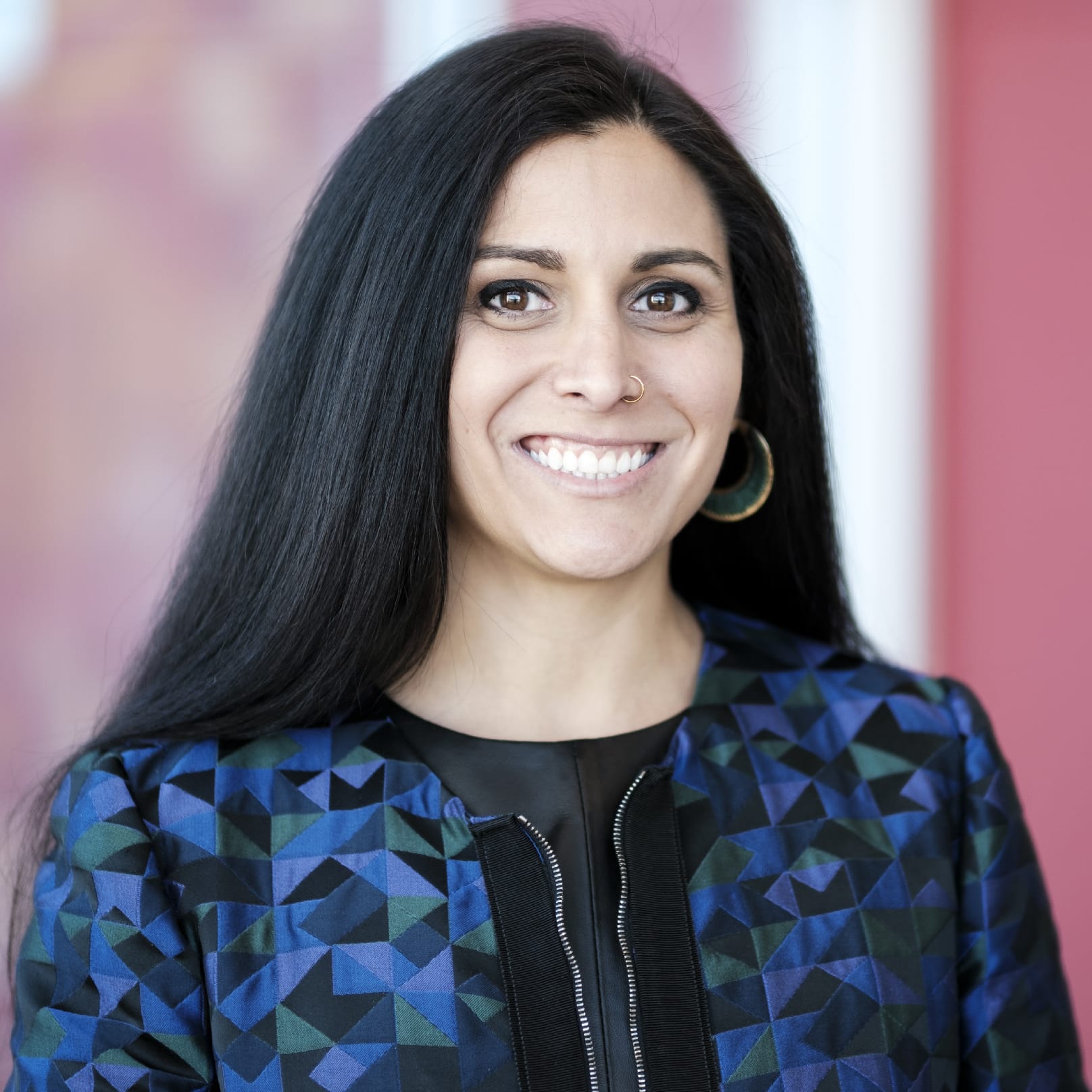
Danielle Murzynsky-Obiekwe
(Chickasaw)
Associate Director
Institutional Advancement
P (505) 428-5931
E d.murzynsky-obiekwe@iaia.edu